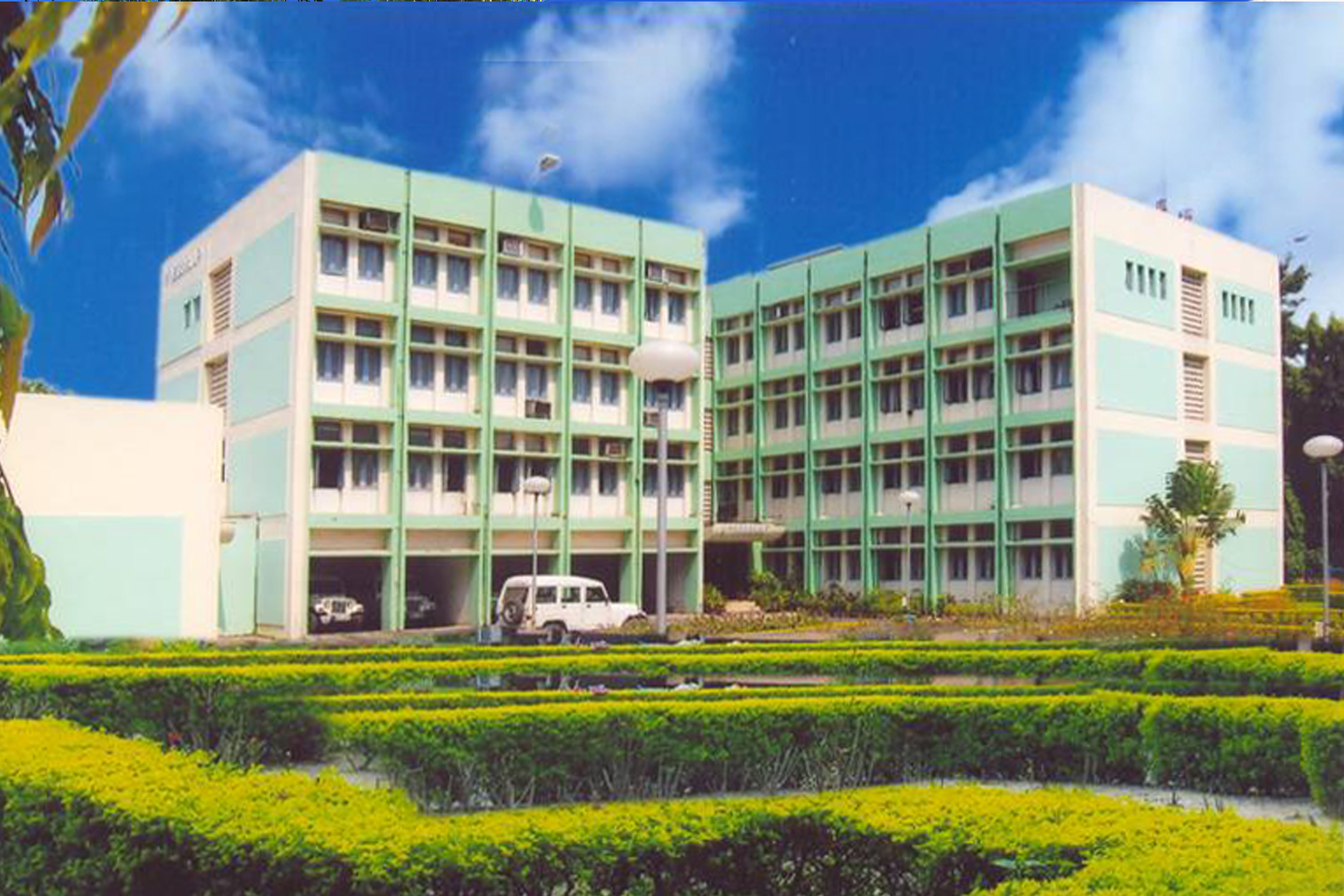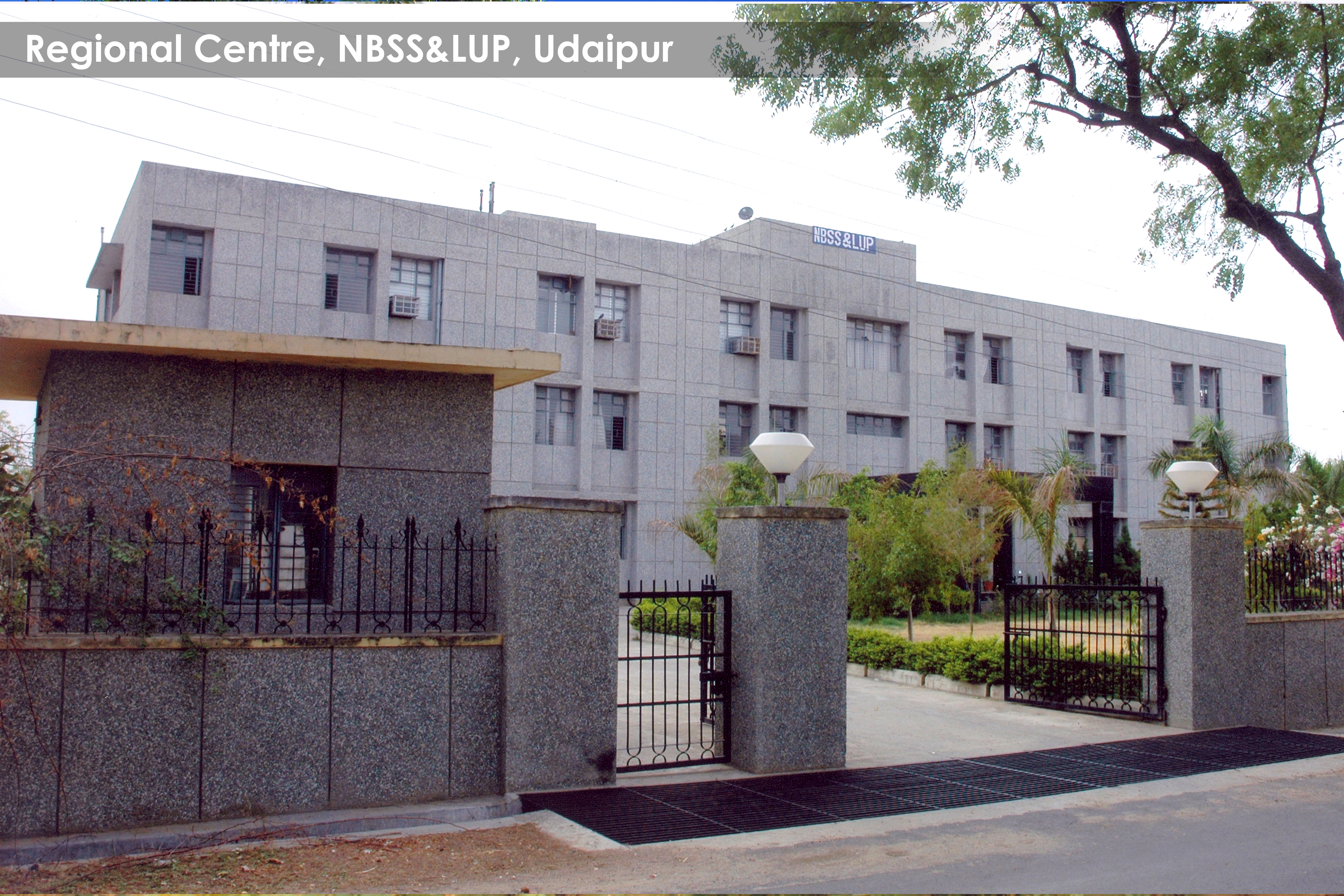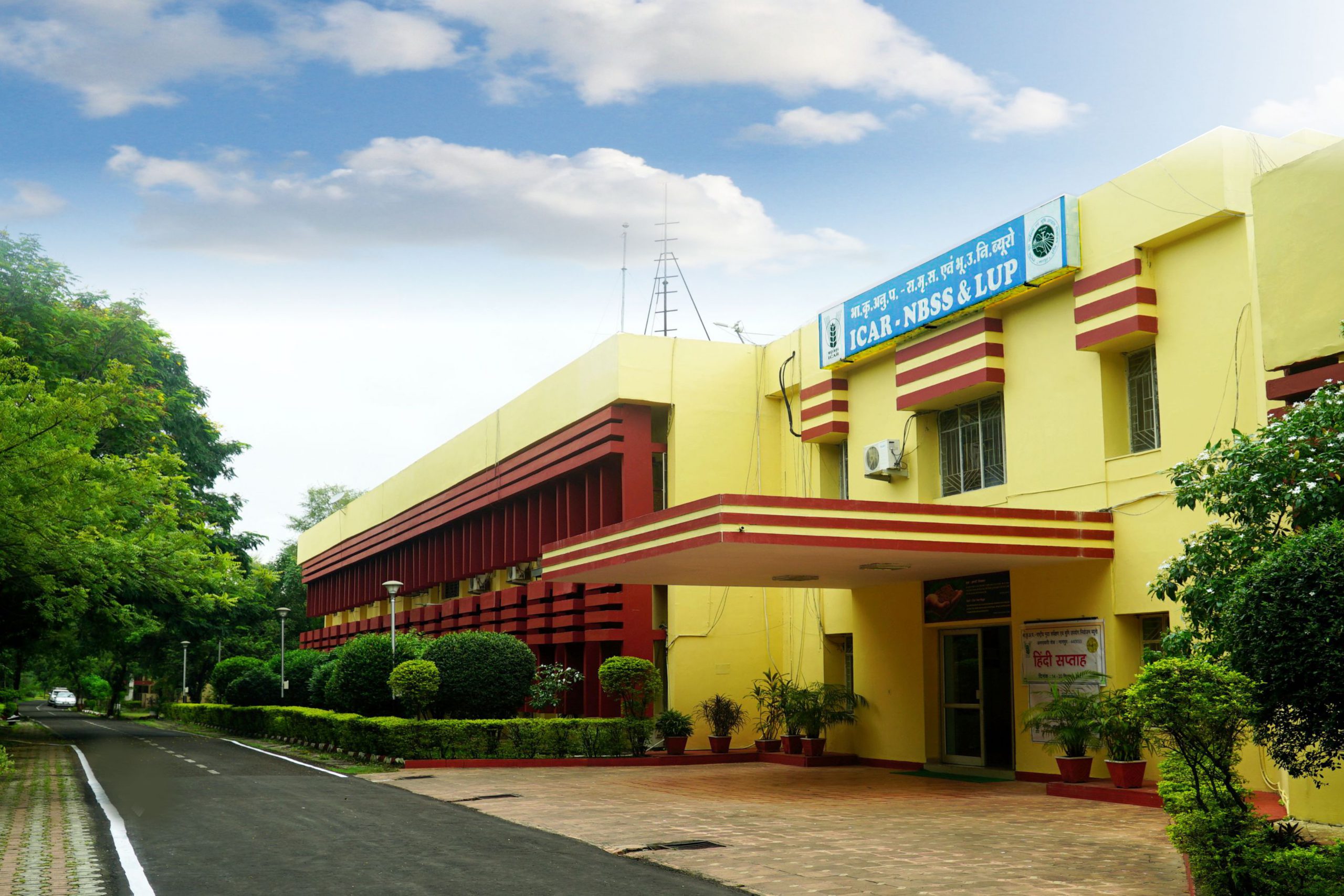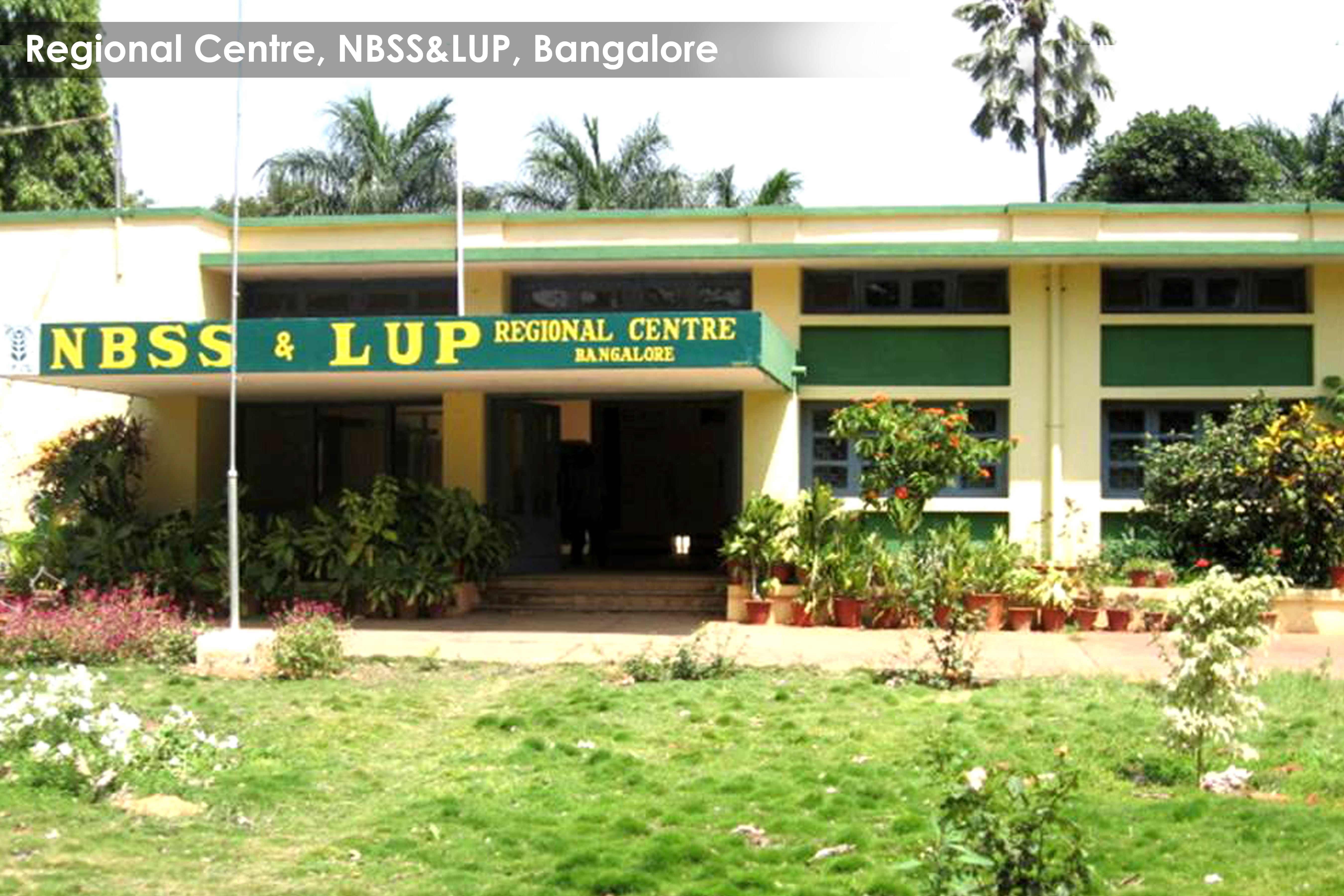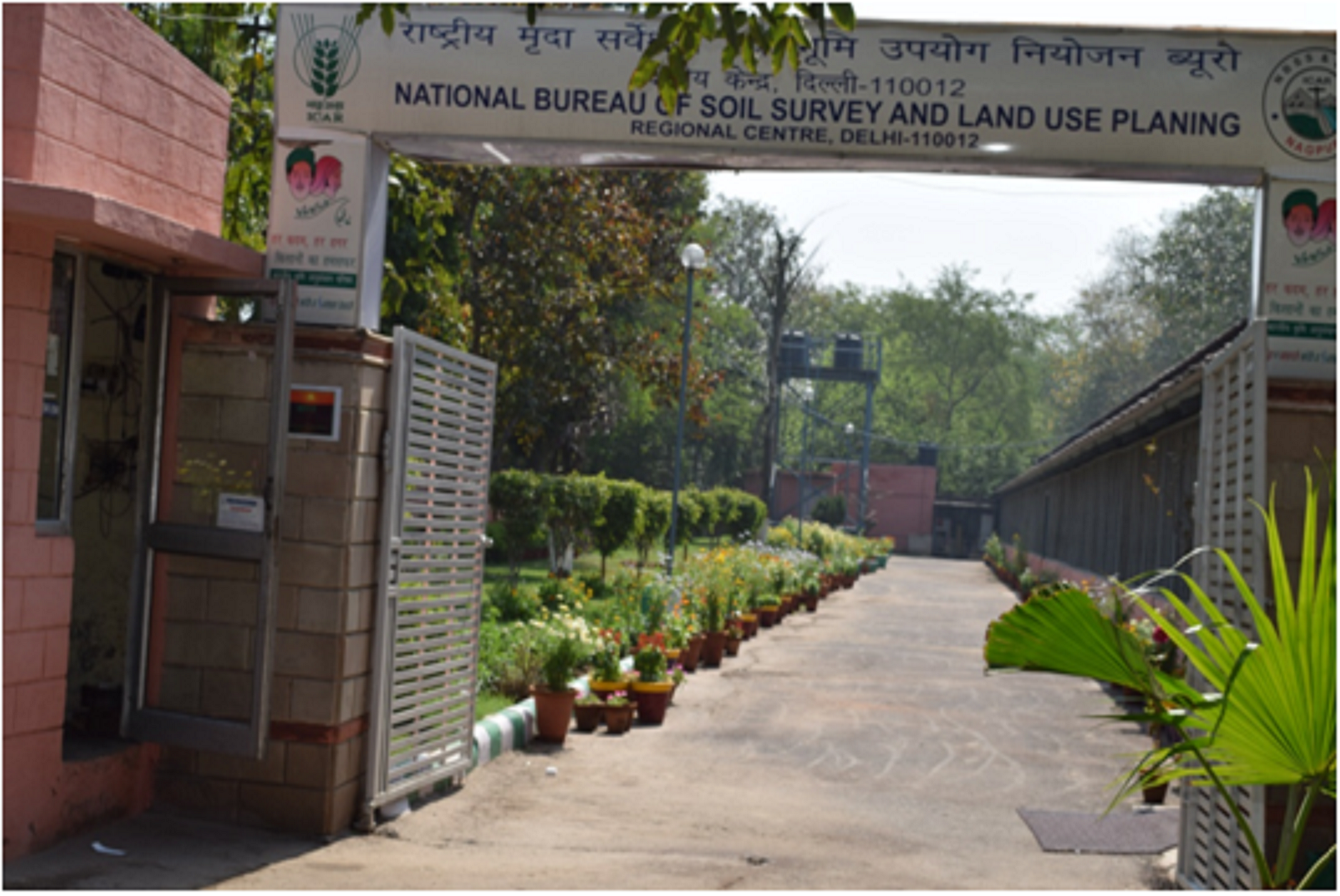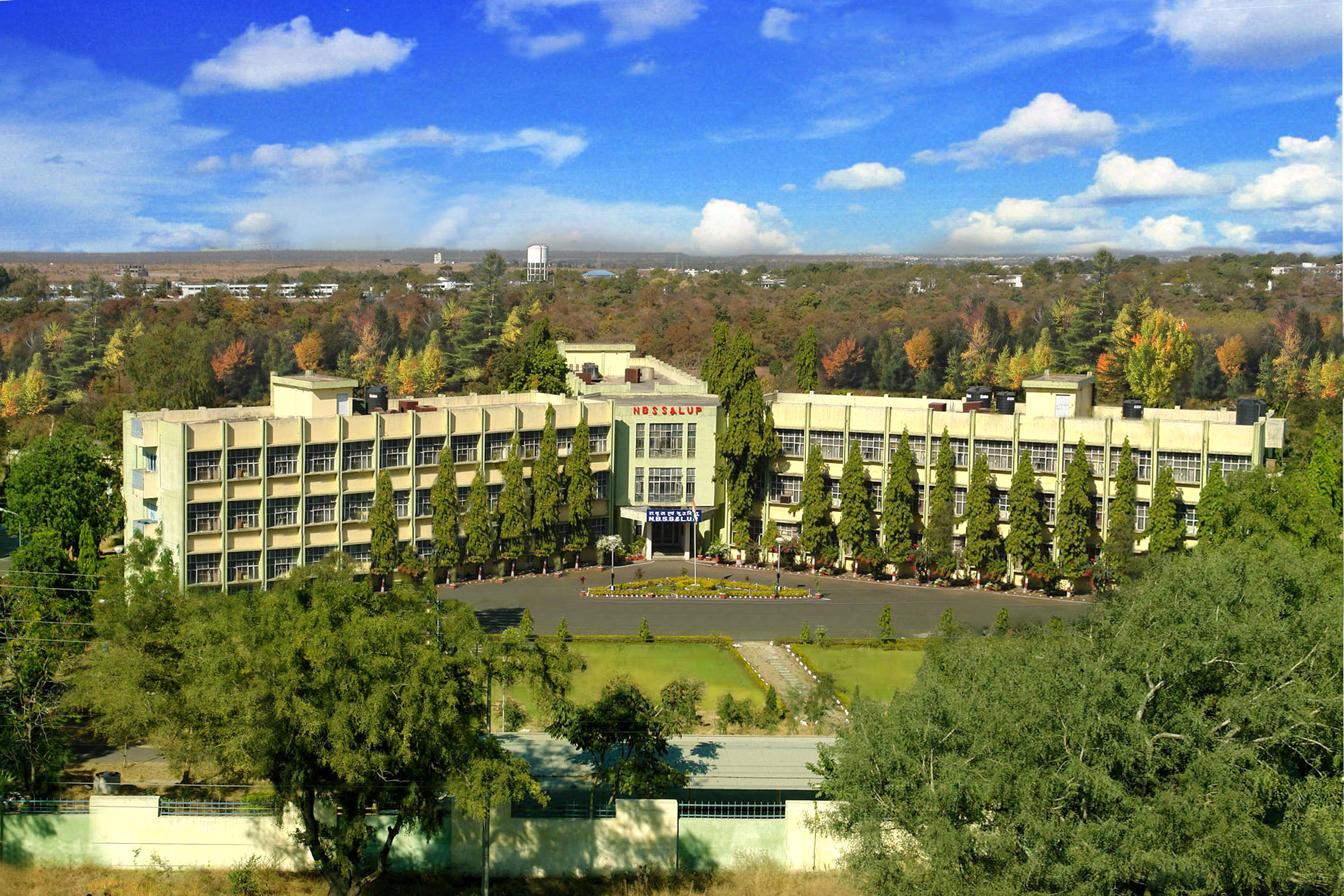About Regional Center : Kolkata
Regional Centre, Kolkata is one among the five regional centers of NBSS&LUP responsible for conducting soil survey and resource mapping of West Bengal, Bihar, Jharkhand, Odisha and Andaman & Nicobar Islands. The Regional Centre is a self equipped unit, engaged in satisfactory execution of land resource inventory at farm/ village/ block/ district levels together with soil correlation and classification, pedological research, remote sensing and GIS application for land management practices, assessment of soil degradation and henceforth optimizing suitable agricultural land use plan at site specific mode.
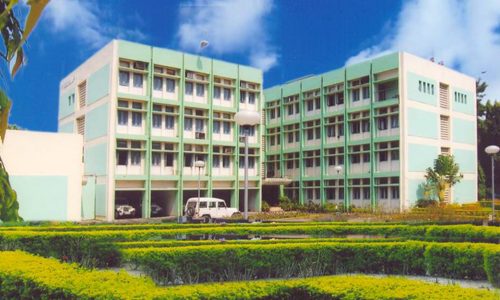
| Sr.No. | Name | Designation | Discipline | Biodata | PMS | |
|---|---|---|---|---|---|---|
| 1 | Dr. Feroze Hasan Rahman | Principal Scientist & Head | Soil Science | Feroze.Rahman@icar.gov.in | View Biodata | – |
| 2 | Dr. Sanjay K. Ray | Principal Scientist | Soil Science | Sanjay.Ray@icar.gov.in | View Biodata | PMS |
| 3 | Dr.(Mrs.) Tapti Banerji | Principal Scientist | Geography | Tapati.Banerjee@icar.gov.in | View Biodata | – |
| 4 | Dr.Kuntal Mouli Hati | Principal Scientist | Agricultural Physics | kuntal.hati@icar.org.in | View Biodata | PMS |
| 5 | Dr. Sah Kausar Reza | Principal Scientist | Soil Science | S.Reza@icar.gov.in | View Biodata | PMS |
| 6 | Dr. S. Bandyopadhyay | Principal Scientist | Soil Science | S.Bandyopadhyay@icar.gov.in | View Biodata | PMS |
| 7 | Dr.(Ms) S. Gupta Choudhury | Senior Scientist | Soil Science | S.Chaudhary@icar.gov.in | View Biodata | PMS |
| 8 | Dr. S. Chattaraj | Senior Scientist | Soil Physics / SWCE | chattaraj.iari@gmail.com | View Biodata | PMS |
| 9 | Dr.(Mrs.) Amrita Daripa | Scientist | Environmental Science | Amrita.Daripa@icar.gov.in | View Biodata | PMS |
| 10 | Dr. Ruma Das | Scientist | Soil Science | ruma.das@icar.gov.in | View Biodata | – |
Excellent facility of ground trutsting
The Regional Centre is continuously monitoring the soil resources of the Eastern Region with soil survey field parties consisting of a scientist, technical, field assistant and driver. The survey parties are well equipped with modern tools and techniques of remote sensing and GPS to capture the temporal variations in soil resources on account of land use policy and management. Ground truths are being verified in the field using latest fine resolution open sourced remotely sensed multi-spectral imageries as well as high resolution open sourced digital terrain data
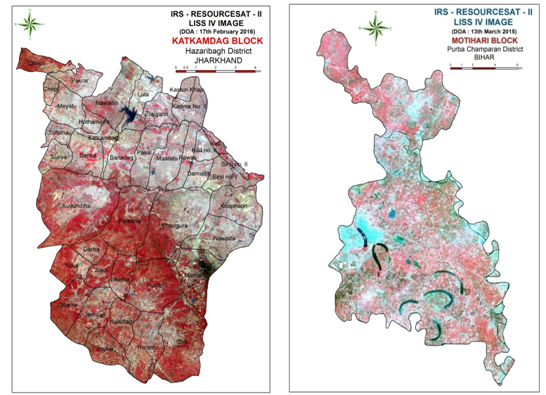
Well equipped physical and chemical Laboratory
The chemical laboratory of the Regional Centre is well equipped with the modern and heavy duty instruments like atomic absorption spectrophotometer (Shimadzu), Carbon and Nitrogen analyzer, flame photometer, UV-visible spectrophotometer, pH meter, conductivity meter, Kjeldhal distillation apparatus, digestion chamber,BOD-incubator, and other related instruments for analysis of chemical and biological properties and fertility status of the soils.The physical laboratory also has the sophisticated instruments namely pressure plate apparatus, suction apparatus, oven, apparatus for mechanical analysis, centrifuges, shakers etc. for the analysis of various physical properties of the soils. 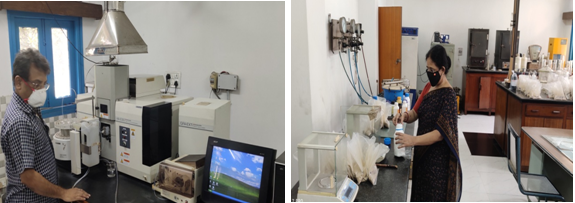 Cartography
Cartography
The section is equipped with huge number of topographical sheets, aerial photographs,satellite images, miscellaneous maps and diagrams, soil maps and atlases on various scales. Facilities for conventional drawing such as N.C. Scriber for lettering, drafting machine for drawing, optical pantograph for reduction and enlargement, planimeter and curvimeter for area processing, plan printer for plain paper reproduction and ammonia printing machine, nova trace etc. are available for cartographic work. Remote sensing equipments, such as mirror stereoscope, sketch master, parallel bar, stereo pentameter etc. are also used in the centre for visual interpretation of aerial photographs and satellite images for the preparation of base maps. In addition,lamination, and binding machine is also available to strengthen catography sectiion.
GIS Laboratory
The Regional Centre is well equipped with some of the latest computer systems and soft- wares with heavy duty work stations that help in data base management, data processing, analysis, storage and retrieval in bulk amount. Advanced software on Geographic Information System such as Arc GIS ver. 10.5, TNT mips, IGIS, QGIS, etc. are being used for regular GIS works viz., terrain modeling, landform analysis, accurate delineation of soil boundaries and generation of geo-referenced soil-database, soil and associated thematic and interpretative maps preparation and data mining. The laboratory is also equipped with Digital Image Processing Software (Image Analyst), Digital Elevation Model generating software (Terrain Analyst) and CAD software like Bentlay’s Micro-station, etc.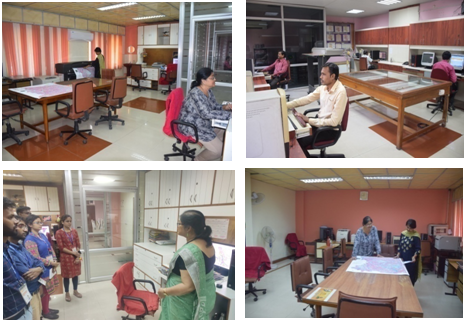
Soil Resource Information Centre (SRIC)
The Soil Resource Information Centre (SRIC) for Eastern Region pertaining to the states of West Bengal, Bihar, Jharkhand, Odisha and Union Territory of A & N Islands have been established at the Regional Centre, Kolkata of ICAR-NBSS & LUP for the use of policy makers, planners, research workers, user agencies as well as the students of schools, colleges and universities. The major objective was to prepare a brief record of the dominant soils occurring in the eastern region in the form of displaying macro monolith of the soils of various agro-ecosystem with their detailed properties and also to serve as a centre for documentation about the activities of the Regional Centre including human resource development programme pertaining to soil survey for land evaluation, generation of thematic maps using GIS technology and soil based agro-technology transfer towards rational land use plan. Geology of different physiographic regions of Eastern states, including a model of watershed, typical soil profile monoliths, sketch of representative landforms, soil-physiographic relationship, a sketch of different soil forming process in various landscape situations of Eastern region has been aesthetically displayed in SRIC.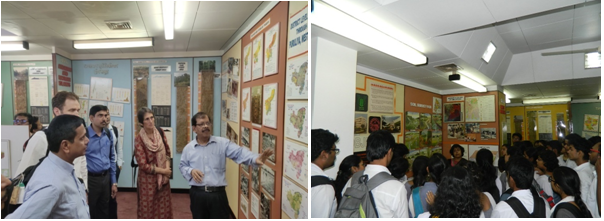
Library
A well-stocked library and documentation unit is prevailing in the Regional Centre. A comprehensive collection of books, journals, reports are present in the library. This caters to the need of the Scientists, Researchers and Post Graduate students and other technical staff of the institute for gaining vast knowledge in the field of natural resource management. The catalogue has been electronically updated every year for filtering the need of users as and when required. 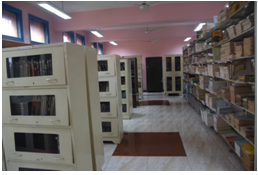
Human Resource Development Unit
The Regional Centre is enriched with well organized HRD unit, comprising well furnished air conditioned conference room and seminar hall for organizing lectures, seminars, symposia, workshops and conducting training programmes from time to time. 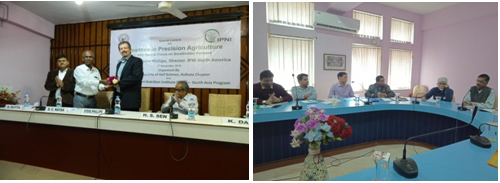
Residential Campus and Scientist Home
The Regional Centre, Kolkata consists of 28 Residential quarters and a Scientist Home having 17 rooms with a capacity of providing logistic facility to 34 guests at a time.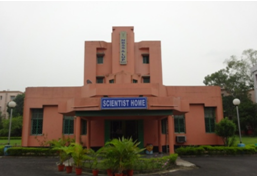
Soil resource mapping of Eastern region for planning at state level (1:250,000 scale)
The soils of the region was surveyed and mapped on 1:250,000 scale following three tier approach. Soil physiographic models were used for mapping the soils of the region and maps are published state wise on 1:500, 000 scale. The soil maps show 115, 119, 99, 159, 69 and 42 map units of soil family associations in West Bengal, Bihar, Jharkhand, Odisha and Andaman Nicobar Island, respectively. Inceptisols were the dominant soils in West Bengal, covering 49% area of the state, whereas, the extent of Alfisols and Entisols were 25 and 23 % area in the state. In Bihar, Inceptisols were the dominant soil order covering 42.4 % area of the state, whereas, the contributions of Alfisols, Entisols and Vertisols were 16.7, 36.8 and 0.3 %, respectively, in the state. In Jharkhand, Alfisols were the dominant soil order, covering 54.6 % area of the state. In Odisha, Inceptisols cover 48.8 % area , whereas, the extent of Alfisols, Entisols and Vertisols were 33.5, 10.2 and 5.52% of area of respectively.
Soil resource mapping for district level planning (1:50,000 scale)
District level soil resource mapping has been accomplished on 1:50,000 scale with soil series association as mapping unit. The exercise has been completed for Bankura, Barddhaman, Birbhum, Hughli, Kochbihar, Nadia and Purulia districts of West Bengal; Madhubani district in Bihar; Lohardaga and Ranchi districts in Jharkhand; Puri and Sambalpur districts in Odisha and South Sikkim district in Sikkim.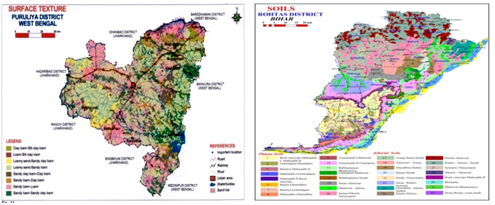
Nutrient status mapping for soil health monitoring
District level soil nutrient mapping status mapping has been accomplished in Jharkhand, West Bengal and Sikkim at 2.5 km, 1.0 km and 0.5 km grid interval, respectively. The spatial database has been created in Arc GIS 9.3 using spatial interpolation technique by geo-statistical method. In West Bengal, about 52.3 to 81.8 % of area was affected with slight to strong acidity, 55 to 92.9 % of area under potassium deficiency, 48 to 88 % of area under phosphorus deficiency and 59.7 to 83.3 % of area under zinc deficiency. In Jharkhand, soils of about 49 % of the state are extremely to strongly acidic and 36% area under moderate to slight soil acidic.. Block level soil nutrient mapping of 38 blocks of Dumka, Jamtara, Hazaribagh and Ramgarh districts of Jharkhand has also been performed at 500 m grids interval. The data indicate that multi-nutrient deficiencies of phosphorous, nitrogen, sulphur, boron and soil acidity problems had been the reasons for low agricultural productivity in these districts.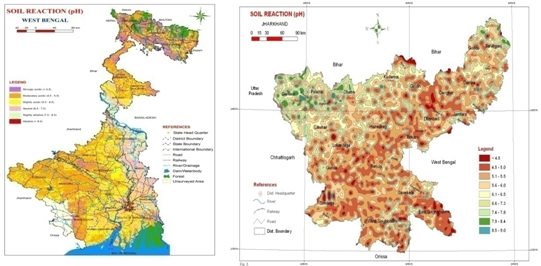
Established soil series for developing benchmark sites in the region
The response of similar soil families to the management and their performance with respect to the crop productivity are not alike because of inherent variability in the soils. The variability in soils of the same families was further narrowed down by establishing soil series in the region. In the process data collected during soil resource mapping of India on 1:250,000 scale; data recorded during district surveys and the soil survey data of other state agencies were utilized. The information on soil series is published in the shape of bulletins for each state of the region. The soil series in the bulletin is described with respect to its type location, physiographic position, ground water table, rainfall, slope, erosion, relief, drainage, permeability, land use, geology and parent material, extent and distribution, associated soils and soil correlation. The soil series description also contains typifying pedons, range in characteristics, interpretations (constraints, suggested land use and potential yield), actual crop yield and analytical soil data. Total 62 soil series are established in the region comprising 38 soil series in West Bengal, 2 soil series in Bihar, 6 soil series in Jharkhand, 11 soil series in Odisha and 5 soil series in Sikkim.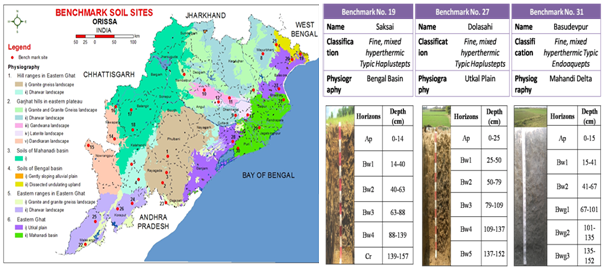
Soil erosion assessment for monitoring degradation status
Following multi-criteria overlay, several critical parameter of soil erosion was integrated in GIS for West Bengal, Odisha, Jharkhand, Bihar and Sikkim for developing quantitative soil erosion of different states of the region.
West Bengal
Central and southern part of the state covering around 79.8 % area was very slightly (loss of soil estimated < 5 ton/ha/yr.) to slightly (loss of soil estimated 5-10 ton/ha/yr.) eroded, while eastern Himalayas and undulating terrain of western region, covering 19.8 % area of West Bengal was moderately (loss of soil estimated 10-15 ton/ha/yr) to severely eroded (loss of soil estimated 20-40 ton/ha/yr.) A part of eastern Himalaya and the adjoining region, occupying another 0.39 % area of the state was very severely eroded (loss of soil estimated 40-80 ton/ha/yr).
Bihar
The soil erosion map of Bihar indicated that the central and northern parts in 87 % area of the state were very slightly to slightly eroded. The hilly area of eastern Himalayas and undulating terrain of southern part, covering another 12.4 % area of the state were moderately to severely eroded. Rohtas, Paschim Champaran and Kaimur region, representing 0.6 % area of Bihar were very severely eroded.
Jharkhand
Soil erosion map of Jharkhand showed that about 65% of TGA of the state has been affected by soil erosion crossing the soil loss tolerance limit. Severe to extremely severe soil loss pertains to 36.8% of TGA of the state, especially in the districts of Ranchi, Bokaro, Dhanbad and Hazaribagh.
Odisha
Soil erosion map of Odisha elucidates that Coastal and Garhjat plains, a part of Mahanadi basin and Dandakaranya on 7.7 million hectare land were very slightly eroded. Another 2.8 million hectare area in Mahanadi basin was slightly eroded, while a part of Eastern ghat and Garhjat hills, covering 4.1 million hectare land in the state was moderately to severely eroded. Very severe and extremely severe eroded soils were located in the hilly terrain of Eastern ghat and Garhjat hilly area.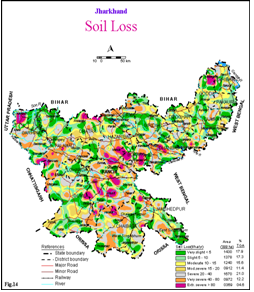
Assessment of Distribution and Extent of Acid Soils of Eastern States
Acid soils occupy about 90 M ha (more than 25% of TGA of the country) and are spread across Himalayan Region, Eastern and North-eastern Plains, Peninsular India and Coastal Plains. About 25 Mha of cultivated lands comprise chemically degraded acid soils soil with pH <5.5. The assessment revealed that 84.9% of total geographical area (TGA) of Jharkhand has been affected by soil acidity, whereas, for West Bengal, Odisha, Bihar and Sikkim the distribution of acid soils were estimated as 53.6, 85.3, 55.7 and 25.1% of TGA of respective states.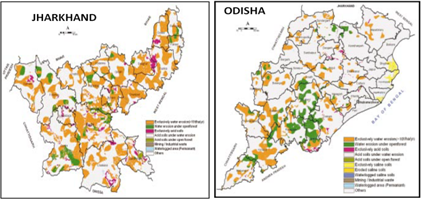
Agro-ecological zoning of West Bengal
For delineating the uniform area with respect to climate, soils and land use, agro-ecological maps have been prepared within the agro-ecological region and sub-regions by superimposing bio-climate, length of growing period map, soils and landforms on 1:1 million scale in GIS. In the exercise twenty nine agro-ecological zones have been carved out for West Bengal (Fig.). For further narrowing down the variability agro-ecological unit map has been delineated within agro-ecological zones by superimposing LGP (10 days interval based on actual AWC), bio-climate on soil physiographic maps.
Characterization and Delineation of Prime Lands of West Bengal
Prime lands were delineated separately for red and lateritic and alluvial tracts and later on combined to obtain the tentative prime agricultural land map for the whole state. The exercise revealed an area of 33929.45 sq.km (38.23 % of TGA) and 3818.79 sq.km (4.3 % of TGA) in alluvial and red and lateritic tract, respectively as prime lands which accounts for 50182.66 sq.km (56.54 % of TGA) in the state.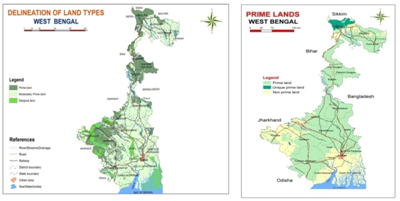
Characterization of Simana Sub-watershed in Subarnarekha Catchment, West Bengal for Land Use Planning using IRS Data
Reconnaissance soil survey was carried out in Simana subwatershed (9100 ha), West Medinipur, West Bengal. Twenty soil series were identified and mapped into 21 soil mapping units. Soils are classified in Alfisols (35.8%), Inceptisols (57.9%) and Entisols (6.3%). Various soil based thematic maps were prepared and a rational land use options were suggested.
Watershed level soil survey work accomplished
West Bengal
- Upper Kasai Watershed, Purulia district,
- Patloi Nala micro-watershed, Hura block, Purulia distrct,
- Simana sub-watershed, Jhargram sub-division, West Medinipur district,
- Silai Basin, Rarh Region, Bankura and Purulia districts,
- Mamring watershed in Darjiling district, West Bengal;
- Major Watersheds in Tista Basin,
Jharkhand
- Subarnrekha watershed, Ranchi district,
- Tilsimani Nala micro-watershed, Kanke block, Ranchi district,
- Potpota watershed (Muramu Cluster), Bero block, Ranchi district,
- Jumar Sub-Watershed, Ranchi district,
Bihar
- Gurusti Nala Watershed, Palamu, Bihar.
Odisha
- Kanchinala micro-watershed, Puri, Odisha,
Sikkim
- Mini Watersheds of the River Tista, Namthang Circle, South Sikkim,
- Singhik Subwatershed, Mangan, North Sikkim,
- Chalumthang Microwatershed, Sikkim;
Village/Research Farm level soil survey work accomplished
State : West Bengal
- Detailed soil survey of Jute Agri. Res. Institute (ICAR), 24-Parganas (N).
- Seven village of Sonarpur PS, 24-Parganas district (S).
- Sagar Island, 24-Parganas district (S).
- Bagnan, district Haora, West Bengal.
- Debra and Tamluk, Medinipur district.
- Tufanganj and Dinahata, Kochbihar.
- Soils of Singibhita Mouza Comprehensive area development corporation, Silliguri-Nakshalbari project, district Darjeeling.
- Soils of Ratua comprehensive area development project, District Malda, West Bengal.
- Soils of Gelia and Maynapur group of villages, Jaypur PS Indo-British Fertilizer Education Project, Bankura dist.
- Soils of Deganga comprehensive area development project, District 24-Parganas (North).
- Detailed Soil Survey for Land Use Planning of BCKV Central Farm (Gayashpur), Nadia
- Detailed Soil Survey for Land Use Planning, Chakdah Farm, BCKV, Dist. Nadia, West Bengal.
- Soils of IVRI Farm (ICAR), Kalyani, Nadia district
State: Jharkhand
- Detailed soil survey of Indian Lac Research Institute Farm, Namkum
- Detailed Soil Survey of Shankarpur and Masipiri Farms of Central Rainfed Upland Rice Research Station (ICAR), Hazaribagh, Jharkhand
- Central Horticultural Experiment Station, PS. Namkum and Hatia, District Ranchi.
- Operational Research Project Area, Chama and Barhu villages, Kanke PS., Ranchi district.
State: Odisha
- Soil Survey of the Land Colonization Project at Kanijodi, Dist. Koraput, Odisha
- Soil survey report of Central Tuber Crops Research Institute Farm (ICAR), Aiginia, Bhubaneswar, Odisha
- Soil survey report of Sisal Research Farm.
- Soils of Central Rice Research Institute Farm, Cuttack
UT: Andaman and Nicobar
- Detailed soil survey of ICAR Farm, Village Pronthropur, Tehsil
Others
- Soil resources of Jaldapara Researved forest, Jalpaiguri dist.
- Soil resources of Garumara Researved forest, Jalpaiguri district.
- Forest soils of Medinipur dist.
- Forest soils of Bankura district.
- Forest soils of Puruliya district.
- Development of regional scale watershed plans and methodo-logies for identification of critical areas for prioritized land treatment in the watersheds (NATP-RRPS-17).
District level land use planning of Nadia, West Bengal at 1: 50,000 scale (Lower Gangetic Plains-Bengal Basin-AESR 15.1)
All the LMUs were evaluated for identifying economically viable and bio-physical suitable crops and cropping systems. Nine LMUs were delineated in the district. Different constraints were identified in each farming system and options were suggested to improve the productivity of crops. Evaluation of soil site suitability for different crops revealed that 22.7, 15.4, 9.5 and 5.1 per cent area of the district are highly suitable for rice, jute, rapeseed/mustard and groundnut respectively and about 44, 19, 80, 79, 42, 20 and 30 per cent area of the district are moderately suitable for rice, wheat, jute, rapeseed/mustard, sesame, sugarcane and groundnut respectively. Multiple Goal Linear Programme (MGLP) model has allocated area for different crops with respect to each defined goal. Expected net returns per ha varied from Rs.24,578/- to Rs.29,053/-.under different objectives and to achieve this different crop combinations have been suggested by the model. Decision Support System (DSS) of Nadia district was thus developed by including all the steps involved in land use planning exercise as a capsule in MS-Access for district planners including contingency planning of the district.
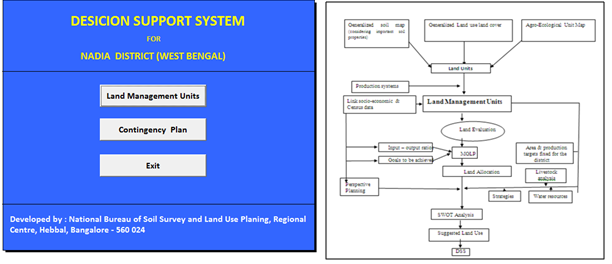
Land Resource Inventory Technology (at 1: 10,000 scale) at block/ district level
The Regional centre has accomplished land resource inventory (LRI) in 8 agro ecological sub regions (AESR 11.0, 12.1, 12.2, 12.3, 13.1, 15.1, 15.3 and 18.5) of Eastern states of India covering 22 blocks of 18 districts of 4 states including Bihar, Jharkhand, Odisha and West Bengal, covering a total geographic area (TGA) of 6,47,851 hectares. IRS Resourcesat 2 LIS IV as well as open source RS data viz., Sentinel-2 imageries along with 3-dimensional surface data like Shuttle Rudder Topographic Mission (SRTM), ASTER-digital elevation model, etc. for accurate delineation of land use –land covers and landform analysis in GIS platform at 1: 10,000scale. Landform analysis revealed micro-topographic variability of geomorphic features with varying slope classes. Landscape ecological unit (LEU) is the unique composition of land use-land covers, landforms and slope, which, represents agro-ecological environment of a given area. This is the basis for soil survey work. The entire procedure is highly effective to reduce time, manpower, energy and overall cost of land resource inventory, efficiently. Use of fine resolution remotely sensed data in GIS environment followed by ground truth verification processes are appeared to be highly useful tools for identification and mapping of prime lands, barren and waste lands, gullied and other degraded lands, fallow lands, forest covers, etc. without compromising the risks of mapping error. The present endeavour lucidly illustrates soil-landform relationship at micro-topographic variability for accurate delineation of soils at 1: 10,00 scale towards site specific management and planning. District level land resource inventory programme (at 1: 10,000 scale) has also been initiated for 8 districts of 4 states, namely, Hazaribagh (AESR 11.0) and Sahibganj (AESR 12.3 and 15.1) of Jharkhand, Jalpaiguri (AESR 15.3), Nadia (AESR 15.1), Murshidabad (AESR 15.1) and Maldah (AESR 15.1) of West Bengal, Katihar (AESR 13.1) of Bihar and Bolangir district (AESR 12.1 and 12.2) of Odisha. Delineation of landscape ecological units (LEU) was accomplished in 120 blocks of 8 districts of 4 states covering a total geographic area of 32,16,300 hectares.
Developing Optimal Agricultural Land Use Plan and Assessment of Economic Impact of Land Resource Inventory
For impact assessment of LRI, the economic performances of crops, plantations, fishery, etc. have been evaluated in three distinct phases viz., (i) traditional or existing cropping/ land use systems, (ii) LRI based suggested alternate cropping/ land use systems and (iii) LRI based land use plan with best management practices (BMP). Economic impact of LRI was assessed for each LMU considering average annual Benefit: Cost (B: C) ratio and average annual net returns (NR) per hectare of land under each phase as indicators. Impact assessment was evaluated in 23 blocks of 18 district of 4 states. It was revealed that, in Dumka block of Dumka district (Jharkhand) and in Katkamdag block of Hazaribagh district (Jharkhand), B:C ratio in LRI based LUP with BMP were increased by 133% and 94%, respectively compared to existing system. On the other hand, benefit to cost ratios was only 31.4% in Chakia block of East Champaran district (Bihar) and 35.5% in Kadwa block of Katihar district (Bihar). The lower impact in Kadwa and Chakia blocks were attributed to moderate to severe salinity, moderate alkalinity and high calcareousness of soils along with and coarse silty texture of soils and severe flooding problems. Impact assessment of LRI based land use plan (with BMP) has revealed benefit to cost ratio in LRI based LUP with BMP ranging from 2.07 in Ganjam block of Ganjam district (Odisha) to 2.78 in Maynaguri block of Jalpaiguri district (West Bengal).
Sustainable Agricultural Land Use Planning of Aspirational Districts of Eastern India
As per the Recommendations of NITI-Aayog, Govt. of India, sustainable agricultural land use planning of 45 Aspirational districts of Bihar, Jharkhand, Odisha and West Bengal has been undertaken. Landform delineation of 24 districts has been accomplished using Sentinel-2 data along with SRTM-DEM as base map. Sustainable agricultural land use plan with geo-referenced soil data base has been uploaded in Aspirational District Dash Board of Bhoomi geo-portal for 4 districts of West Bengal (Nadia, Murshidabad, Maldah and Dakshin Dinajpur), 5 from Bihar (Araria, Begusarai, Katihar, Sitamarhi and Sheikhpura), 2 from Odisha (Kalahandi and Rayagada) and 2 from Jharkhand (Pakur and Sahibganj).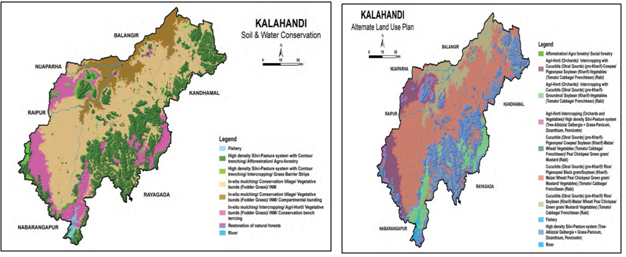
Soil Health Card Programmes
Soil health card programmes were launched in Gosaba block of South 24 Pgs. District of West Bengal during 2016-17 and in Motihari block of East Champaran district, Bihar during 2017-18 and 2018-19. In Gosaba block, 250 soil health cards were distributed to the farmers. In Motihari block, 1700 and 450 soil heath cards were distributed to the farmers of Piprakothi and Motihari blocks, on the occasions of Krishi Kumbh during 10-12th April of 2018 and 2019, respectively, in gracious presence of the Hon’ble former Union Minister of Agriculture, Govt. of India. 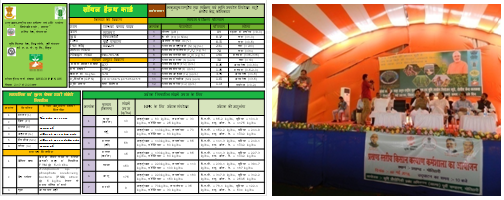
Up scaling of Land Shaping Technology in Gosaba block, South 24 Parganas district for enhancing livelihood of the farmers in coastal region of West Bengal under Lower Gangetic Delta & Coastal Eco-system (AESR 18.5) (under SCSP & STC Programme)
A three tier land use planning approach through land shaping technology facilitated in managing soil and water resources for enhanced crop production towards improving livelihood security of the farmers. Major interventions were: (i) Land shaping techniques (land modification through farm pond, deep furrow and high ridge, shallow furrow and medium ridge and paddy-cum-fish cultivation); (ii) Improved and salt tolerant paddy varieties; (iii) Multiple cropping/ crop diversification (low water requiring cropsc); (iv) Improving homestead production system; and (v) Promotion of vermi-composting and green manuring for reducing input cost. For LMU-1, Water harvest structure (pond) was recommended. Pond dykes may be utilized for fruit crops and multipurpose tree species (MPTS). Uplands were utilized for vegetable cultivation throughout the year. Mid lands were utilized for pulses, oilseeds during the rabi season and paddy during the kharif season and low land was utilized for paddy-fishery. For LMU-3, Paddy-cum-fishery with land shaping technology was adopted). Winter and summer vegetables can be grown on the dykes of the trenches. During rabi season, pulses, oilseed crops can be grown with life saving irrigation water in trenches Economic impact of alternative land management options revealed that the cropping intensity increased to 283% in LMU-1, 296% in LMU-2 and 257% in LMU-3 compared over the baseline 112% (existing). Overall, integrated multiple cropping-cum-fishery increased the average annual net income to Rs. 1,58,730/ ha, including income from vegetables cultivation (Rs. 1,89,266/ ha), paddy (Rs. 39,897/ ha) and pond fisheries (Rs. 1,78,058/ ha). Impact assessment in this endeavour revealed that the beneficial impact on livelihood security has been increased by 7.07 to 9.59 times in different land management units with respect to existing sets of management. One farmer, named Sh. Biswajit has now become a role model among the farmers of the village and has been recognized and awarded as best progressive farmer of Gosaba block by ICAR-CSSRI, Regional Station, Canning Town during celebration of Farmer’s day on 19.10.2016.
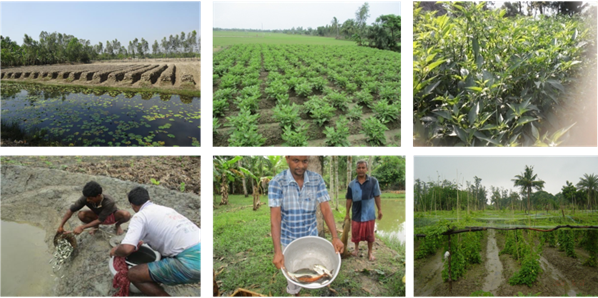
Implementation of agricultural land use planning of Kultali block of 24 Pgs(S), West Bengal (Lower Gangetic Delta & Coastal Eco-system-AESR 18.5)
In each land management unit (LMU) of the block, Aile system of land shaping technology with best management practice (BMP) was adopted to carry out package of practices. The impact analysis showed that Land shaping technology (Ail system) in LMU3 increased the system productivity ranging from 57.0 to 118.0% in different category of famers. The corresponding increase in net return of the system increase by 121 to 248% with paddy equivalent yield ranging from 2.71 to 3.05.
Institute funded project
- Land resource inventory of Sahibganj district, Jharkhand at 1:10000 scale using geospatial techniques.
- Land resource inventory of Murshidabad district, West Bengal at 1:10,000 scale using geospatial techniques.
- Land resource inventory of Maldah district, West Bengal at 1:10,000 scale using geospatial techniques.
- Land resource inventory of Nadia district, West Bengal at 1:10,000 scale using geospatial techniques.
- Land form identification and mapping of aspirational districts of Eastern India.
- Development of land resource inventory based long-term soil organic carbon restorative land use plan in humid sub-tropical region of Eastern India (Jalpaiguri district).
- Agricultural land use planning to enhance productivity and livelihood security of farming community of Majherpara village of Canning-II block, South 24 Parganas district, West Bengal (SCSP Programme)
Externally funded project
- Land resource inventory of Cinchona and other medicinal plants growing area of Darjeeling district on larger scale using geo-spatial techniques
- Dr. S. K. Reza as Course Director organized ICAR Sponsored Winter School on “Application of Remote Sensing and GIS in Land Resource Management for Sustainable Agriculture” during 02- 22 March, 2022, at ICAR-NBSSLUP, Regional Centre, Kolkata.
- Reza, S.K., Chattaraj, S., Mukhopadhyay, S., Daripa, A., Ray, S.K. and Saha, S. 2023. Delineation of high-resolution soil carbon management zones using digital soil mapping: A step towards mitigating climate change in the Northeastern Himalayas, India. Soil Use and Management. doi.org/10.1111/sum.12995. NAAS Rating 9.67
- Ray, P., Sarmah, S., Mourya, K.K. Jena, R.K., Sharma, G.K., Hota, S., Sharma, R.P., Das, B. and Ray, S.K. 2023. Assessment of water quality of the Brahmaputra River in India for irrigation purpose. Journal of Soil and Water Conservation,22(1), 41-46. NAAS Rating 5.20
- Reza, S.K., Alam, N.M., Mukhopadhyay, S.,Nayak, D.C., Sahoo, A.K., Singh, S.K., Dwivedi, B.S., Maurya, D.and Mukhopadhyay, J. 2023.Quantification of soil quality index using pedo-morphological data of alluvial soils of Indo-Gangeticplains, India. Archives of Agronomy and Soil Science, 69(7), 1129-1145. https://doi.org/10.1080/03650340.2022.2067982. NAAS Rating 9.01.
- Vanlalchhuanga, Jena, R.K., Moharana, P., Kumar, N., Sharma, R.P., Das, B., Deb Roy, P. and Ray, S.K. 2023. Modelling and mapping of soil erosion in the north-eastern frontier Himalayan rages of India using remote sensing and GIS. Journal of Soil and Water conservation, 21 (4), 345-353. NAAS Rating 5.20.
- Gangopadhyay, S. K., Ray, S. K., Maitra, A. K., Tiwari, P. and Paul, R.2023. Characteristics and Mineralogy of Some Clay Rich Soils of the Lower Indo-Gangetic Plains of Murshidabad District, West Bengal.Clay Research, 41, 69-81. NAAS Rating 4.37
- Gupta Choudhury, S. and Banerjee, T. 2023. Land Resource Inventory: A Primary Tool for Sustainable Integrated Watershed Management. International Journal of Environmental & Agriculture Research, 9(2), 13-16.
- Daripa, A., Chattaraj, S., Malav, L.C.,Ray, P.,Sharma, R.P., Mohekar, D.S., Ramamurthy V.,Raghuvanshi, M.S. and Patil, N.G.2023. Risk assessment of agricultural soils surrounding an iron ore mining: a field study from Western Ghat of Goa, India. Soil and sediments contamination – an international journal,32(5), 570-590.https://doi.org/10.1080/15320383.2022.2111403 (NAAS Rating 9.06)
2022
- Reza, S.K., Mukhopadhyay, S., Dutta, D., Chattopadhyay, T., Mukhopadhyay, J., Maurya, D. and Dwivedi, B.S. 2022. Soil–landform relationship and pedogenesis of flood Plain soils of Mahananda sub-basin, Bihar. Journal of the Indian Society of Soil Science, 70 (2), 172-
- Reza, S.K., Alam, N.M., Mukhopadhyay, S., Nayak, D.C., Sahoo, A.K., Singh, S.K., Dwivedi, B.S., Maurya, D. and Mukhopadhyay, J. 2022. Quantification of soil quality index using pedo- morphological data of alluvial soils of Indo-Gangetic plains, India. Archives of Agronomy and Soil Science. https://doi.org/10.1080/03650340.2022.2067982
- Reza, S.K., Ray, P., Alam, N.M., Mukhopadhyay, S., Singh, S.K. and Ray, S.K. 2022. Soil properties-landform relationship in Purvanchal range of Tripura, Northeastern India: An implication of pedogenesis. Journal of the Geological Society of India, 98:402- https://doi.org/10.1007/s12594-022-1992-3
- Jena, R.K., Bandyopadhyay, S., Pradhan, Upendra Kumar, Moharana, P.C., Kumar, Nirmal, Sharma, G. K., Deb Roy, P., Ghosh, Dibakar, Ray, Prasenjit, Padua, S., Ramachandran, S., Das, Bachaspati, Singh, S. K., Ray, S. K., Alsuhaibani, A. M., Gaber, A., and Hossain, A. (2022). Geospatial Modelling for Delineation of Crop Management Zones Using Local Terrain Attributes and Soil Properties. Remote Sensing (MDPI) 2022, 14, 2101.https://doi.org/10.3390/rs14092101https://www.mdpi.com/journal/remotesensing
- Gangopadhyay, S.K., Bandyopadhyay, S. and Maitra, A.K. (2022). Characteristics of Soils of Lower Indo-Gangetic Plains of West Bengal under Rice Cultivation. Journal of the Indian Society of Soil Science, 70 (1):pp 21-31
- Bandyopadhyay, S., Gangopadhyay, S.K., Das, K., Ghosh, B.N., Mukhopadhyay, S., Gupta Choudhury, S., Sahoo, A.K., Maitra, A.K. and Haldar, A. (2022). Differential Pedogenesis of Some Pseudo-Andic and Non-Andic Soils in a Toposequence of Andaman and Nicobar Islands. Journal of the Indian Society of Soil Science, 70 (1): pp 32-43.
- Debroy, Partha, Jena, R.K., Ray, P., Sharma, R.P., Bandyopadhyay,S., Ramachandran, S., Mitran, T., Saha, B.N., Singh, S.K. and Ray, S.K. (2022). Assessing the nature of soil acidity in per-humid, Sub-tropical Meghalaya in North Eastern region of India. Journal of Soil and Water Conservation, 21(2): 119-126.
- Daripa, A., Chattaraj, S., Malav, L., Ray, P., Sharma, R.P., Mohekar, D.S., Ramamurthy V., Raghuvanshi, M.S. and Patil, N.G. (2022). Risk assessment of agricultural soils surrounding an iron ore mining: a field study from Western Ghat of Goa, India. Soil and sediments contamination – an international journal. (NAAS- 8.08)
- Daripa, A., Chattaraj, S., Malav, L.C., Sharma, R.P., Naitam, R.K., Mohekar, D.S. and Ramamurthy, V. (2022). Land Use Based Distribution Pattern, Fractionation forms and Health Risk Assessment of Heavy Metals in Mining-affected Soils of Western Ghat of Goa. International Journal of Plant & Soil Science 34(23): 838-854, 2022; Article no.IJPSS.92958, ISSN: 2320-7035. (NAAS- 5.05)
- Sharma, R.P., Chattaraj, S., Jangir, A., Tiwari, G., Dash, B., Daripa, A., Naitam, R.K. (2022). Geospatial variability mapping of soil nutrients for site specific input optimization in a part of central India. Agronomy journal. https://doi.org/10.1002/agj2.21025. (NAAS- 24).
- Yadav, B., Malav, L.C., Moharana, P.C., Daripa, A., Yadav, L.R., and Mina, B.L. (2023). Long term trend analysis of vegetation dynamics over Rajasthan using satellite derived enhanced vegetation index. Agrometeorology (NAAS 6.55).
- Singh, S.K., Mohekar, D.S., Arunachalama, V., Kumar, N., Chattaraj, S., Jena, R.K., Das, Bappa, and Kumar, Praveen (2022). Land resource inventorying (LRI) on 1:10K – National soil priority of India. Geoderma Regional, Volume 29, e00524, ISSN 2352-0094, https://doi.org/10.1016/j.geodrs.2022.e00524. (NAAS- 8.81)
- Jena, R.K., Moharana, P. C., Sahoo, S., Dash, B., Kumar, N., Sharma, G.K., Ray, P., Chattaraj, S., Sharma, R.P., Deb Roy, P., Sandeep, P., Das, B. and Singh, S.K. (2022). Soil erosion risk assessment through morphometric indices for prioritization of watersheds in northeastern region of India using multi-criteria analysis methods. Journal of Soil and Water Conservation 21(1): 7-20. (NAAS- 5.20)
- Hota, Surabhi, Mishra Vidyanand, Mourya Krishna Kumar, Giri Krishna, Kumar Dinesh, Jha Prakash Kumar, SaikiaUday Shankar, Prasad Vara P.V. and Ray, Sanjay Kumar (2022). Land Use, Landform, and Soil Management as Determinants of Soil Physicochemical Properties and Microbial Abundance of Lower Brahamaputra Valley, India. Sustainability, 14: 2241-2258. (https://doi.org/10.3390/su14042241).
- Jena, Roomesh Kumar, Bandyopadhyay, Siladitya, Pradhan, Upendra Kumar, Moharana, Pravash Chandra, Kumar, Nirmal, Sharma, Gulshan Kumar, Deb Roy, Partha, Ghosh, Dibakar, Ray, Prasenjit, Padua, Shelton, Ramachandran, S., Das, Bachaspati, Singh, Surendra Kumar, Ray, Sanjay Kumar, Alsuhaibani, Amnah Mohammed, Gaber, Ahmed, and Hossain, Akbar (2022). Geospatial Modelling for Delineation of Crop Management Zones Using Local Terrain Attributes and Soil Properties. Remote Sensing, 14:2101- 2125. https://doi.org/10.3390/rs14092101.
- ChoudhariPushpajeet L., Prasad J., Ray S.K. and Gurav, P (2022). Genesis and Mineralogy of Teak – Supporting Soils in Seoni District of Madhya Pradesh. J. Ind. Soc. Soil Sci.,Vol 70, No. 2, pp. 160-171.
- Vanlalchhuanga, Jena Roomesh Kumar, Moharana, Kumar Nirmal, Sharma Ram Prasad, Das Bachaspati, Deb Roy Parta and Ray S.K. (2022),. Modelling and mapping of soil erosion in the north-eastern frontier Himalayan rages of India using remote sensing and GIS. J of Soil and Water conservation Vol.21(4), pp 345-353.
2021
- Reza, S.K., Kumar, N., Ramachandran, S., Mukhopadhyay, S., Singh, S.K., Dwivedi, B.S. and Ray, S.K. (2021). Geo‑spatial analysis for horizontal and vertical variability of bulk density, particle‑size distribution and soil moisture content in Tripura, Northeastern India. Arabian Journal of Geosciences, 14:2734. 14:2734. https://doi.org/10.1007/s12517-021-09151-3
- Reza, S.K., Baruah, U., Mukhopadhyay, S., Bandyopadhyay, S. and Sahoo, A.K. (2021). Quantifying spatial variability of available zinc in alluvial soils of Brahmaputra plains, India. Journal of the Indian Society of Soil Science, 69(1):28- https://doi.org/10.5958/0974-0228.2021.00017.7
- Ray, P., Chattaraj, S., Bandyopadhyay, S., Jena, R. K., Singh, S. K., &Ray, S. K. (2021). Shifting cultivation, soil degradation, and agricultural land-use planning in the northeastern hill region of India using geo-spatial techniques. Land Degradation & Development, 1–23. https://doi.org/10.1002/ldr.3986.
- Rathore, A.C., Metha, Harsh; Ghosh,B.N., Islam,. Sadikul; Sharma,N.K., Jayprakash, J., Gupta,A.K., Dube, R.K., Prasad, Ram and Raiza, A. (2021). Biomass, carbon stock estimation and predicting modeling in mango based land uses on degraded lands in Indian Sub-Himlayas. Agroforestry System.95:1563–1575.
- Ray, Prasenjit, Gogoi, S.N., Bandyopadhyay, S., Jena, R.K., Ramachandran, S., Sharma, G.K., Sah, K.D., Singh, S.K. and Ray, S.K. (2021) Soil-cum-nutrient management package for achieving high yield and quality of mulberry (Morus indica L.) leaf in acid soil of North Eastern India. Journal of Plant Nutrition (https://doi.org/10.1080/01904167.2021.1921196).
- Meena, V. S., Ghosh, B.N., Singh, Raman Jeet, Bhattacharyya, Ranjan, Sharma, N.K., Alam, M., Patra Sridhar, dadhwal, K.S. and Mishra, P.K. (2021).Effects of long-term (6 years) nutrient management on soil loss and carbon management index- principal component analysis approach. Indian Journal of Soil Conservation. 49 (3): 1-8.
2020
- Meena, V. S., Ghosh, B.N., Singh, Raman Jeet, Bhattacharyya, Ranjan, Sharma, N.K., Alam, M., Meena, S. K., Mishra, P.K. (2020). Land use types and topographic position affect soil aggregation and carbon management in the mountain agro-ecosystems of Indian Himalayas. Land Degradation and Development.DOI: 10.1002/ldr.3864.
- Mehta, Harsh, Srimali, S.S., Ghosh, B.N., Singh, Charan , Rathore, A.C., Lekh Chand, Raj Kumar, Ojasvi, P.R. and Joshi, B.P. (2020). Productivity potential of cultivated cereals, pulses, oilseeds, grasses, lemon and conservation of natural resources in grassed waterways in north-western Himalayas. Indian Journal of Soil Conservation 48(1): 20-26
- Gangopadhyay, S.K., Bandyopadhyay, S., Mukhopadhyay, S., Nayak, D.C., Sahoo, A.K. and Singh, S.K. (2020). Soil Nutrient Information System (SNIS) in Middle Indo-Gangetic Plain of Bihar, India – A Tool for Land Use Planning. Journal of the Indian Society of Soil Science, 68(1), pp 25-33
- Debroy, P., Jena, R.K., Ray, P., Bandyopadhyay, S., Padua, S., Singh, S.K. and Ray, S.K. (2020) Vertical distribution of cationic micronutrients across landscape positions on Meghalayan plateau in the North-Eastern Region of India, Journal of Environmental Biology, 41:1089-1098.
- Reza, S.K., Ray, P., Ramachandran, S., Jena, R.K., Mukhopadhyay, S. and Ray, S.K. (2020). Soil organic carbon fractions in major land use systems in Charilam block of Tripura. Journal of the Indian Society of Soil Science, 68(4):458- https://doi.org/10.5958/0974-0228.2020.00037.7
- Reza, S.K., Bandyopadhyay, S., Baruah, U., Sarkar, D. and Singh, S.K. (2020). Spatial distribution of plant available nutrients in different landforms of Bongaigaon district, Assam. Agropedology, 30(01):31−36. https://doi.org/10.47114/j.agropedo.2020.jun4
- Sahoo, Sonalika, Vasu, Duraisamy. Paul, Ranjan, Sen, Tarun Kanti, Ray, Sanjay Kumar and Chandran, Padikkal (2020) Acid Soils of Manipur of the North-eastern Region of India : Their Mineralogy, Pedology. Taxonomy and Edaphology. Clay Research, 39(1):31-43.
- Gangopadhyay, Samar K. and Ray, S.K. (2020) Soil Chemical and Mineralogical Characteristics under Major Land Use Systems on Upper Brahmaputra Valley of Assam. Clay Research, 39(2):56-66.
- Gaikwad, Sujay, S., Prasad Jagdish, Ray, S.K. and Srivastava, Rajeev. (2020). Characteristics, Mineralogy and Spectral Properties of Some Typical Vertisols of Vidarbha, Maharashtra, India. J. Ind. Soc. Soil Sci., 68:367-384.
2019
- Reza, S.K., Ray, P., Ramachandran, S., Bandyopadhyay, S., Mukhopadhyay, S., Sah, K.D., Nayak, D.C., Singh, S.K. and Ray, S.K. (2019). Profile distribution of soil organic carbon in major land use systems in Bishalgarh block, Tripura. Journal of the Indian Society of Soil Science, 67(2):236- https://doi.org/10.5958/0974-0228.2019.00026.4
- Reza, S.K., Dutta, D., Bandyopadhyay, S. and Singh, S.K. (2019).
- Spatial variability analysis of soil properties of Tinsukia district, Assam, India, using geostatistics. Agricultural Research, 8(2):231- https://doi.org/10.1007/s40003-018-0365-z
- Reza, S.K., Ray, P., Ramachandran, S., Bandyopadhyay, S., Mukhopadhyay, S., Sah, K.D., Nayak, D.C., Singh, S.K. and Ray, S.K. (2019). Spatial distribution of soil nitrogen, phosphorus and potassium contents and stocks in humid subtropical North-eastern India. Journal of the Indian Society of Soil Science, 67(1):12- https://doi.org/10.5958/0974-0228.2019.00002.1
- Singh, Raman Jeet, Deshwal, S. Sharma, N.K., Ghosh, B.N. and Bhattacharyya, Ranjan. (2019). Effects of conservation tillage based agro-geo-textiles on resource conservation in sloping croplands of Indian Himalayan Region. Soil Tillage Research.191: 37-47.
- Ghosh, B.N., Bandyopadhyay, S. and Das, K. (2019). Transformation of Resource Conservation Technologies to Conservation Agriculture Can be Climate Smart Agriculture— A Few Perspectives for Eastern India. SATSA Mukhapatra – Annual Technical Issue, 23: 18-28.
- Gupta Choudhury, S., Banerjee, T., Das, K., Sahoo, A.K., Nayak, D.C. and Singh, S.K. (2019).Soil Resource Characterization and Classification under Different Toposequences in Eastern Extension of Chhotanagpur Plateau. Journal of the Indian Society of Soil Science,67(1): 1-11.
- Bandyopadhyay, S., Ghosh, B.N., Sahoo, A.K., Mukhopadhyay, S., Halder, A., Nayak, D.C. and Singh, S.K. (2019). Developing land use plan through advanced land resource inventory (LRI) technique in Chhotanagpur plateau region of Jharkhand. Indian Journal of Soil Conservation, 47 (1): 63-73.
- Nayak, D.C., Haldar, A., Sahana, K., Bandyopadhyay, S. and Singh, S.K. (2019). Forms and Distribution of Potassium in Some Selected Soils of Sahibganj District, Jharkhand, Developed from Rajmahal Trap. Journal of the Indian Society of Soil Science,67 (2): 192-198.
- Gaurav .P. Priya, Ray, S.K., Choudhari, P.L., Shirale, A.O., Meena, B.P., Biswas, A.K. and Patra, A.K. (2019) Potassium in shrink-swell soils of India: an enigma. Current Scince, 117(4):587-596.
2018
- Ghosh, B.N., Bandyopadhyay, S., Mukhopadhyay, S., Das, K., Nayak, D.C. and Singh, S.K. (2018). Optimization of Soil Organic Carbon through Particle Size Fractions and Cation Exchange Capacity in Humid Sub-Tropical Climate of Eastern India for Land Use Planning. Clay research, 37 (2): 67-73 (Published in august, 2019).
- Ghosh, B.N., Meena, V.S., Singh, R.J., Alam, N.M., Shridhar, Patra, Bhatacharyya, Ranjan, Sharma, N.K., Dadhwal, K.S. and Mishra, P.K. (2018). Effects of fertilization on soil aggregation, carbon distribution and carbon management index of maize-wheat rotation in the north-western Himalayas. Ecological Indicator. DOI.org/10.1016/j.ecolind.2018.02.050 (NASS-9.9).
- Gupta Choudhury, S., Yaduvanshi, N. P. S., Chaudhari, S. K., Sharma, D. R., Sharma, D. K., Nayak, D. C. and Singh, S. K. (2018). Effect of nutrient management on soil organic carbon sequestration, fertility, and productivity under rice-wheat cropping system in semi-reclaimed sodic soils of North India. Environmental Monitoring and Assessment190:117. https://doi.org/10.1007/s10661-018-6486-9.
- Padua, S., Chattopadhyay, T., Bandyopadhyay, S., Ramachandran, S., Jena, R.K., Ray, P., Deb Roy, P., Baruah, U., Sah, K.D., Singh, S.K. and Ray, S.K. (2018). A simplified soil nutrient information system: study from the North East Region of India. Current Science,114 (6): 1241-1249.
- Dash, Ch. J., Adhikary, P.P., Madhu, M., Mukhopadhyay, S., Singh, S.K. and Mishra, P.K. (2018). Assessment of spatial changes in forest cover and deforestation rate in Eastern Ghats Highlands of Odisha, India,Journal of Environmental Biology, 39. p 196-203.
- Reza, S.K.,Baruah, U., Nayak, D.C., Dutta, D. and Singh, S.K. (2018). Effects of Land-use on Soil Physical, Chemical and Microbial Properties in Humid Subtropical Northeastern India. National Academy Science Letters, DOI: 1007/s40009-018-0634-1.
- Bandyopadhyay, S., Ray, R., Padua, S., Ramachandran, S., Jena, R.K., Deb Roy, P., Dutta, D.P., Baruah, U., Sah, K.D., Singh, S.K., Nayak, D.C., and Ray, S.K. (2018). Forms of acidity in soils developed on different landforms along an altitudinal sequence in Nagaland, India. Journal of the Indian Society of Soil Science, 66(2): 125-135.
- Bandyopadhyay, S., Ray, R., Padua, S., Ramachandran, S., Jena, R.K., Deb Roy, P., Dutta, D.P., Baruah, U., Sah, K.D., Singh, S.K., Nayak D.C. and Ray, S.K. (2018). Priority zoning of available micronutrients in the soils of agroecological sub-regions of north-east India using geo-spatial techniques. Agricultural Research (Springer), https://doi.org/10.1007/s40003-018-0327-5.
- Gupta Choudhury, S., Banerjee, T., Das, K., Sahoo, A. K., Nayak, D. C., Singh, S. K. (2018). Methodology of land resource inventory at 1:10000 scale for, agricultural land use planning- a case study in eastern extension of Chhotanagpur plateau region. Environmental Analysis and Ecology Studies, Crimson Publisher (USA)2(1): 1-8, EAES.000530.2018.
- Bandyopadhyay, , Ghosh, B.N., Ray, P., Ramachandran, S., Jena, R.K., Deb Roy, P., Singh, S.K., Mukhopadhyay, S., Nayak, D.C. and Ray, S.K. (2018). Impact assessment of land resource inventory towards optimizing land use plan in Brahmaputra valley ecosystem, Assam, India. Indian Journal of Soil Conservation,46 (1): 1-8.
- Reza, S.K., Dutta, D., Bandyopadhyay, S. and Singh, S.K. (2018). Spatial variability analysis of soil properties of Tinsukia district, Assam, India. Agricultural Research (Springer),https://doi.org/10.1007/s40003-018-0365-z.
- Reza, S.K., Ray, S.K., Nayak, D.C. and Singh, S.K. (2018). Geostatistical and multivariate analysis of heavy metal pollution of coal-mine affected agricultural soils of north-eastern India. Journal of the Indian Society of Soil Science,66(1): 20-
- Mandal, S., Sah, K.D., Das, K., Sahoo, A.K., Reza, S.K., Nayak, D. C., Singh, S. K., Burman, D., Sharma, P.C., Chakraborty, P. P. and Sarkar, S. (2018). Increasing small holder formers income through alternate land use options in costal salt affected areas of West Bengal. Journal of Soil Salinity and Water Quality,10(2): 268-278.
- Jena, R.K., Padua, S., Ray, P., Ramachandran, S., Bandyopadhyay, S., Deb Roy, P., Obi Reddy, G.P., Singh, S.K. and Ray, S.K. (2018). Assessment of soil erosion in sub tropical ecosystem of Meghalaya, India using remote sensing, GIS and RUSLE. Indian Journal of Soil Conservation, 46 (3): 139-145.
- Gangopadhyay, S.K., Obi Reddy, G.P., Nayak, D.C. and Singh, S.K. (2018). Land Resource Inventory and Mapping: Tools and Techniques, In:Reddy, G.P.O. and Singh, S.K. (eds) Geospatial Technologies in Land Resource Mapping, Monitoring and Management. Geotechnologies and Environment,Springer, Cham, 21: 297-322.
- Ray, Prasenjit, Gogoi, S. N., Bandyopadhyay, S., Padua, S., Jena, R. K., Deb Roy, P., Ramachandran, S., Sharma, G. K., Sah, K. D., Trivedy, K., Singh S. K. and Ray, S. K. (2018). Fertility status of mulberry (Morus indica L.) growing soils of upper Brahmaputra valley region of north eastern India. Range Management and Agroforestry,39 (2): 147-155.
- Ray, S.K. (2018) Phosphorus in Our Soil Environment. Journal of the Indian Society of Soil Science, 66 (Supplement):165-178. (published in 2020)
- Gurav, P. Priya, Datta, S.C., Ray, S.K., Choudhari, P.L. and Ahmed, N. (2018) Assessment of potassium release threshold levels of Vertisols (shrink-swell soils) in different agro-ecological regions of India. Applied Clay Science, 165:155-163.
- Bhattacharyya, T., Ray, S.K., Chandran, P., Karthikeyan, K. and Pal, D.K. (2018) Soil quality and fibrous mineral in black soils of Maharashtra. Current Science, 115(3):482-492.
- Vasu, Duraisamy, Tiwary, Pramod, Chandran, Padikkal, Singh, Surendra Kumar, Ray, Sanjay Kumar, Butte, Pravin and Parhad, Vilas (2018) A conceptual model of natural land degradation based on regressive pedogenesis in semiarid tropical environments. Land Degrad. & Dev., DOI:10.1002/Idr.3000 (https://doi.org/10.1002/Idr.3000.
- Gurav, P. Priya, Ray, S.K., Choudhari, P.L., Biswas, A.K. and Shirale, A.O. (2018) A review on soil potassium scenario in verisols of India. Open Access Journal of Science. DOI: 10.15406/oajs.2018.02.00051.
- Chattopadhyay, T., Nayak, D.C., Mukhopadhyay, S., Sahoo, A.K. and Singh, S.K. Land Evaluation for Crop Planning in Soils of Indo-Gangetic Plains of Hugli District, West Bengal, Indian Agriculturist, Vol.59(4), pp. 215-222.
2017
- Reza, S.K., Nayak, D.C., Mukhopadhyay, S., Chattopadhyay, T. and Singh, S.K. (2017). Characterizing spatial variability of soil properties in alluvial soils of India using geostatistics and geographical information system. Archives of Agronomy and Soil Science, (DOI 10.1080/03650340.2017.1296134).
- Reza, S.K., Singh, S., Datta, S.C., Purakayastha, T.J. and Singh, S.K. (2017). Phosphorus solubilization through organic acids production in pressmud composted with rockphosphate. National Academy Science Letters,40(1): 13-16 (DOI 10.1007/s40009-016-0511-8).
- Gupta Chaudhury, S., Banerjee, T., Das, K., Sahoo, A.K., Nayak, D.C.and Singh, S.K. (2017). Characterisation and classification of different rice growing soils with spatial emphasis on soil organic carbon stock in Rajnagar block of Birbhum district, West Bengal, Agropedology, 26(2), 198-207
- Ghosh, B.N., Das, K., Bandhyopadhyay, S., Mukhopadhyay, S., Nayak, D.C and Singh,S.K. (2017). Impact assessment of GIS based land resource inventory towards optimizing agricultural land use plan in Dandakaranya and Easternghats physiographic confluence of India. Journal of the Indian Society of Remote Sensing. DOI:10.1007/s12524-017-0743-1 (NASS-6.3).
- Srinavasan, R., Singh, S.K., Nayak, D.C. and Naidu, L.G.K. (2017). Characterisation, classification and evaluation of cashew growing soils in Coastal Odisha for sustainable production, Agropedology, 26(2), 178-188.
- Srinivasan, R.; Singh, S.K.,Nayak, D.C. and Dharumarajan, S.(2017). Assessment of Soil Properties and Nutrients Status in three Horticultural Land Use System of Coastal Odisha, India – International Journal of Bio-resource and Stress Management, Vol.8 (1)33-40.
- Srinivasan, R.: Singh,S.K.; Chattopadhyay , T.; Gangopadhyay, S.K.; Nayak, D.C. and Mukhopadhyay, S. (2017). Characterization of Soils and Cropping Pattern of Coastal West Bengal – A Case Study in Canning II Block. Journal of Soil Salinity and Water Quality 9(2), 249-256.
- Srinivasan, R.; Singh, S.K and Nayak, D.C (2017). Assessment of Soil Degradations in Coastal Ecosystem of Sundarbans, West Bengal- A Case Study. Journal of Soil Salinity and Water Quality 9(2), 257-269.
- Srinivasan, R.; Nayak, D.C and Singh, S.K. (2017). Distribution of Nutrients in Sundarbans – A Case Study. Agropedology, Vol.27 (01),42-47.
- Nayak, D.C., Bandyopadhyay S., Sahoo, A.K., Reza, S.K. and Singh, S.K. (2017). Characterization of some cracking clay soils of Rajmahal Trap in Sahibganj district, Jharkhand, Clay Research, 36 (2): 55-63.
- Bandyopadhyay, S., Ray, P., Ramachandran, S., Jena, R.K., Singh, S.K. and Ray, S.K. (2017). Pedogenesis of ome Hydromorphic soils of upper Brahmaputra valley region, Assam, India. Clay Research, 36 (2): 77-89.
- Wakode, Roshan, Prasad, Jagdish, Chandran, P., Ray, S.K., Bhattacharyya, T. and Patil, N.G (2017) Mineralogy of Soils along Toposequence in Raipur District of Chattisgarh. Agropedology, 27:167-176.
- Gurav, P. Priya, Ray, S.K., Choudhari, P.L., Bhattacharyya, T., Chandran, P., Kharche, V.K., Tiwary, P. and Biswas, A.K. (2017) Characterization of some Vertisols of Different Agro-ecological Regions of India. Agropedology, 27:84-92.
- Satyavathi, P.L.A., Tiwary, P., Bhaskar, B.P., Ray, S.K., Prasad, Jagdish and Bobde, S.V. (2017) Pedotransfer Functions to Estimate Soil Water Retention Characteristics in Major Cotton Growing Shrink-swell Soils of Yavatmal District, Maharashtra. Journal of the Indian Society of Soil Science, 65:379-386.
- Vasu, D., Singh, S.K., Tiwary, P., Sahu, N., Ray, S.K., Butte, P. and Duraisami, V.P. (2017) Influence of geochemical processes on hydrochemistry and irrigation odelingty of groundwater in place of semi-arid Deccan Plateau, India. Applied Water Science, pp. 1-13. Doi: 10.1007/s13201-017-0528-2.
2016
- Reza, S.K., Nayak, D.C., Chattopadhyay, T., Mukhopadhyay, S., Singh, S.K. and Srinivasan, R. (2016). Spatial distribution of soil physical properties of alluvial soils: a geostatistical approach. Archives of Agronomy and Soil Science, 62:972-981.
- Dutta, Dipak, Bandyopadhyay, Siladitya, Baruah, Utpal and Sarkar, Dipak. (2016). Characterizations of Soil at Different Landforms in Hilly Areas of Meghalaya State. Journal of the Indian Society of Soil Science, 64, No. 3, pp 302-309.
- Reza, S.K., Baruah, U., Singh, S.K. and Srinivasan, R. Spatial heterogeneity of soil metal cations in the plains of humid subtropical northeastern India. Agricultural Research,5(4): 346-352 (DOI 10.1007/s40003-016-0217-7)
- Reza, S.K.,Baruah, U., Sarkar, D. and Singh, S.K. (2016). Spatial variability of soil properties using geostatistical method: a case study of lower Brahmaputra plains, India. Arabian Journal of Geosciences, 9: 446 (DOI 10.1007/s12517-016-2474-y).
- Reza, S.K., Baruah, U. and Singh, S.K. (2016). Spatial distribution of Fe and Mn in paper mill effluent affected agricultural soils in Morigaon, Assam. Agropedology,26 (02): 87-
- Sahoo, A.K., Nayak, D.C., Mukhopadhyay, S., Banerjee, T., Singh, S.K., Sarkar, D., Sarkar, A.K., Agarwal, B.K. and Shahi, D.K. (2016). Mapping of Block Level Soil Fertility Status of Dumka District, Jharkhand using GPS and GIS, Indian Journal of Fertilisers, Vol. 12(7),50-57.
- Srinivasan, R.; Mukhopadhyay, S.; Nayak, D.C. and Singh, S.K. (2016). Characterization, Classification and Evaluation of Soil Resources in Coastal Eco-system – A Case Study of Gosaba Block (Part), South 24-Parganas, West Bengal, Agropedology, 25(2), pp.195-201.
- Srinivasan, R.; Reza, S.K.;Nayak, D.C.;Singh, S.K. and Sarkar, G.C. (2016). Characterization and Classification of Major Vegetables Growing Soils of Odisha Coastal System – A Case Study, Agropedology, 25(2), pp.232-239.
- Vasu Duraisamy, Singh, Surendra Kumar, Ray, Sanjay Kumar, Duraisami, V. Perumal, Tiwary, Pramod, Chandran, Paikkal, Nimkar, Anant M. and Anantwar, Shyam G. (2016). Soil quality index (SQI) as a tool to evaluate crop productivity in semi-arid Deccan plateau, India. Geoderma, 282:70-79.
- Vasu, , Singh, Surendra Kumar., Tiwary, Pramod., Chandran, Padikkal., Ray, Sanjay Kumar and Duraisami, Veppangadu Perumal. (2016) Pedogenic processes and soil-lanform relationships for identification of yield-limiting soil properties.Soil Research, doi: org/10.1071/SR16111.
- Thakur, Pravin B., Bhattacharyya, Tapas, Ray, S.K., Chandran, P., Pal, D.K. and Telpande, B.A. (2016) Re-search Shrink-Swell Measurement and Relationship with Soil Properties of Black Clayey Tropical Vertisols. Clay Research, 35(2):37-54.
- Jena, R. K., Duraisami, V.P., Sivasamy, R., Shanmugasundaram, R., Krishnan, R., Padua, S., Bandyopadhyay, S., Ramachandran, S., Ray, P., Roy, P. Deb, Singh, S. K. and Ray, S. K. (2016) Characterization and Classification of Soils of Jirang Block in Meghalaya Plateau, Agropedology, 26 (01), 47-57.
- Padekar, Deepak, Bhattacharyya, T., Ray, S.K., Tiwary, P. and Chandran, P. (2016) Influence of irrigation water on black soils in Amravati district, Maharashtra. Current Science, 110(9): 1740-1755.
- Nath, A.J., Bhattacharyya, T., Deka, Jyotirupa, Das, Ashesh Kumar Das and Ray, S.K. (2016) Management effect on soil organic carbon pools in lowland rain-fed paddy growing soil. Journal of Tropical Agriculture, 53(2): 131-138, 2015.
- Nath, A.J., Bhattacharyya, T., Ray, S.K., Deka, Jyotirupa, Das, Ashesh Kumar Das and Devi, Huma. (2016) Assessment of rice farming management practices based on soil organic carbon pool analysis. Tropical Ecology, 57(3): 607-611.
2015
- Gangopadhyay, S.K., Bhattacharyya, T. and Sarkar, D. (2015). Hydromorphic soils of Tripura : their pedogenesis and characteristics. Current Science 108, (5): 984 – 993.
- Gangopadhyay, S.K., Obi Reddy, G.P., Mukhopadhyay, S. and Singh, S.K. (2015). Characterization of landforms and soils in complex toposequence of Subarnarekha catchment, Chhotanagpur plateau using Remote Sensing and GIS. Agropedology. 25, 95-109.
- Bhattacharya R; Ghosh B.N, Mishra P. K., Mandal B., Srinivas Rao C., Sarkar D., Das K., Aarty K S, Lalitha M., Mouli K. H and Franzluebbers A. J. (2015). Soil degradation in India: Challenges and potential solutions, Sustainability, 7, 3528 – 357. mdpi.com/journal/sustainibility
- Reza, S.K., Baruah, U. and Singh, S.K. (2015). Accumulation and translocation of heavy metals in soil and crop irrigated with Paper mill effluents. Journal of the Indian Society of Soil Science,63: 242-244.
- Reza, S.K., Baruah, U. and Singh, S.K. (2015). Multivariate approaches for soil fertility characterization of lower Brahmaputra valley, Assam, India. Journal of the Indian Society of Soil Science, 63: 379-
- Jena, R. K., Duraisami, V.P., Sivasamy, R., Shanmugasundaram, R., Krishnan, R., Padua, S., Bandyopadhyay, S., Ramachandran, S., Ray, P., Roy, P. Deb, Singh, S. K. and Ray, S. K. (2015) Spatial Variability of soil fertility parameters in Jirang block of Ri-Bhoi district, Meghalaya, Clay Research, 34(1):35-45.
- Bhattacharyya, T., Chandran, P., Ray, S.K., Mandal, C., Tiwary, P., Pal, D.K., Maurya, U.K., Nimkar, A.M., Kuchankar, H., Sheikh, S., Telpande, B.A. and Kolhe Ashwini. (2015) Walkley-Black recovery ractorto reassess soil organic matter: Indo-Gangetic Plains and Black Soil Region of India case studies. Communicatios in Soil Science and Plant Analysis, 46:2628-2648.
- Bhattacharyya, T., Chandran, P., Ray, S.K., Pal, D.K., Mandal, C. and Mandal, D.K. (2015) Distribution of zeolitic soils in India. Current Science, 109(7):1305-1313.
- Bhattacharyya, T., Ray, S.K., Maurya, U.K., Chandran, P., Pal, D.K., Durge, S.L., Nimkar, A.M., Sheikh, S.M., Kuchankar, H.W., Telpande, B., DongreVishakha and Kolhe Ashwini (2015) Carbon and nitrogen estimation in soils: Standardizing methods and internal standards for C/N analyzer. Indian Chem. Soc., 92:263-269 p.
- Ambekar, Abhijit. S., Sridhar D. N., Ray, S.K., Bhattacharyya, T., Anantwar, S.G., Sahu, V. T. and Gaikwad, M. S. (2015) Research Communication: Probable Source of rocks for millstone and cannon balls of goa, India. Current Science, 108, (02):273-282 p.
2014
- Singh, S. K., Sidhu, G. S., Gupta Choudhury, Shreyasi., Pandey, C. B., Banerjee, T. Sarkar, D. (2014). Soil organic carbon density in arable and non-arable lands under varied soil moisture and temperature regimes in cold arid to sub-tropical areas of Western Himalaya, India. Arid Land Research and management 28:2, 169-185.
- Gupta Choudhury, Shreyasi, Srivastava, S., Singh, R., Chaudhari, S. K., Sharma, D. K., Singh, S. K., Sarkar, D. (2014). Tillage and residue management effects on soil aggregation, organic carbon dynamics and yield attribute in rice–wheat cropping system under reclaimed sodic soil. Soil and Tillage Research 136, 76-83.
- Pushpanjali, K., Karthikeyan; Sahu, S.S., Sahoo, A.K. and Sarkar Dipak (2014). Delineation and prioritization of Jumar sub-watershed for sustainable development using geospatial techniques, Journal of Indian Soil Conservation, Vol.42(1), pp. 39-45.
- Bandopadhyay, S., Dutta, D., Chattopadhyay, T., Reza, S.K., Dutta, D.P., Baruah, U., Sarkar, D. and Singh, S.K. (2014). Characterization and classification of some tea-growing soils of Jorhat district, Assam. Agropedology24(2): 138-
- Banerjee, T., Singh, S.K., Dharumarajan, S., Sarkar, Dipak (2014). Integration of high resolution satellite data, DEM and GIS for large scale mapping – A Case study from lower Gangetic Alluvial Plain of India. International Journal of Geomatics and Geosciences5(2): 345-356.
- Baruah, U., Bandopadhyay, S. and Reza, S.K. (2014). Land use planning and strategic measures in North Eastern Region of India. Agropedology24(2): 292-
- Bhattacharyya, T., et al. (2014). Soil information system: use and potentials in humid and semi-arid tropics. Current Science107(9): 1550-
- Bhattacharyya, T., et al. (2014). Georeferenced soil information system: assessment of database. Current Science107(9): 1400-
- Chandran, P., et al. (2014). Development of soil and terrain digital database for major food-growing regions of India for resource planning. Current Science107(9): 1420-
- Chatterji, S., et al. (2014). Land evaluation for major crops in the Indo-Gangetic Plains and black soil regions using fuzzy model.Current Science107(9): 1502-
- Dutta, D., Baruah, Utpal, Sarkar, Dipak and Dutta, D.P. (2014). Undulating the feasibility of rabi cropping through soil moisture characterization in Sibsagar district of Assam, India. Indian Journal of Soil Conservation 42: 46-53.
- Kumar, A., Srivastava, A.K., Velmourougane, K., Sidhu, G.S., Mahapatra, S.K., Singh, R.S., Sahoo, A.K., Das, K., Das, T.H., Reza, S.K., Bhattacharyya, T., Sarkar, D. and Sharma, A.K. (2014). Urease activity and its kinetics in selected benchmark soils of Indo-Gangetic Plains, India. Proceedings of the National Academy of Sciences, India Section B: Biological Sciences (DOI 1007/s40011-014-0352-5).
- Mandal, C., et al. (2014). Revisiting agro-ecological sub-regions of India – a case study of two major food production zones. Current Science107(9): 1519-
- Patil, N.G., et al. (2014). Natural resources of the Indo-Gangetic Plains: a land-use planning perspective. Current Science107(9): 1537-
- Ray, S.K., et al. (2014). Soil and land quality indicators of the Indo-Gangetic Plains of India. Current Science107(9): 1470-
- Raychaudhuri, M., et al. (2014). Soil physical quality of the Indo-Gangetic Plains and black soil region. Current Science107(9): 1440-
- Reza, S.K.,Baruah, U. and Singh, S.K. (2014). Soil risk assessment of heavy metal contamination near Oil Refinery area, Northeastern India. International Journal of Agriculture, Environment & Biotechnology7(4): 787-
- Reza, S.K.,Baruah, U. Nath, D.J., Sarkar, D. and Gogoi, D. (2014). Microbial biomass and enzyme activity in relation to shifting cultivation and horticultural practices in humid subtropical North-eastern India. Range Management and Agroforestry 35(1): 78-
- Reza, S.K., Baruah, U., Dutta, D., Sarkar, D. and Dutta, D.P. (2014). Distribution of forms of potassium in Lesser Himalayas of Sikkim, India. Agropedology24(1): 106-
- Reza, S.K., Baruah, U., Singh, S.K. and Das, T.H. (2014). Geostatistical and multivariate analysis of soil heavy metal contamination near coal mining area, Northeastern India. Environmental Earth Sciences (DOI 10.1007/s12665-014-3797-1).
- Sidhu, G.S., et al. (2014). Impact of management levels and land-use changes on soil properties in rice–wheat cropping system of the Indo-Gangetic Plains. Current Science107(9): 1487-
- R., Jeevan Rao K., Sailaja, V. and Kalaivanan. D. (2014). Influence of organic manures and fertilizers on nutrient uptake, yield and quality in cabbage-baby corn cropping sequence. Journal of Horticultural Sciences9(1):48-54.
- Srivastava, A.K., et al. (2014). Impacts of agro-climates and land use systems on culturable microbial population in soils of the Indo-Gangetic Plains, India. Current Science107(9): 1464-
- Tiwary, P., et al. (2014). Pedotransfer functions: a tool for estimating hydraulic properties of two major soil types of India. Current Science107(9): 1431-
- Velmourougane, K., et al. (2014). Impacts of bioclimates, cropping systems, land use and management on the cultural microbial population in black soil regions of India. Current Science107(9): 1452-
- Venugopalan, M.V., et al. (2014). InfoCrop-cotton simulation model – its application in land quality assessment for cotton cultivation. Current Science 107(9): 1512-
- Deshmukh, H.V., Chandran, P., Pal, D.K., Ray, S.K., Bhattacharyya, T., and Potdar, S.S. (2014) A Pragmatic Method to Estimate Plant Available Water Capacity (PAWC) of Rainfed Cracking Clay Soils (Vertisols) of Maharashtra, Central India. Clay Research, 33: 1-14.
- Padekar, D.G., Bhattacharyya, T., Deshmukh, P.D., Ray, S.K., Chandran, P. and Tiwary, P. (2014) Is irrigation water causing degradation in black soils? Current Science, 106: 1487-1489.
2013
- Singh, S.K., Kumar, Mahesh, Pandey, C.B., Sarkar, Dipak, Ghosh, Anupam, Mukhopadhya, S.(2013). Soil properties between irrigation and cropping sequence in Thar desert of India. Journal of Arid Land Research and Management, Vol.27 (1): 17-23.
- Nayak, D. C. and Sarkar, Dipak. (2013). Mineralogy of Some Benchmark Soils of the Coastal Plain, West Bengal. Clay Research.32 (1): 1-16.
- Dutta, D.; Banerjee, Tapati and Sarkar Dipak (2013). Length of growing period assessment in Bankura district for micro-level crop planning, Agropedology, 22(2), 80-87.
- Dinesh, R. and Ghoshal Chaudhuri, S. (2013). Soil biochemical / microbial indices as ecological indicators of land use change in mangrove forest. Ecological Indicators32, 253-258. (An ELSIVER publication).
- Bannerjee, Tapati, Das, K., Singh, S.K and Sarkar Dipak (2013). Microwatershed in ChotanagpurPlateau,West Bengal, India-evaluation of Sabai Grass as alternate farming options, Range Management &Agroforestry,Vol34(1).
- Reza, S.K., Baruah, Utpal, Chattopadhyay, T. and Sarkar Dipak (2013). Distribution of forms of potassium in relation to different agro-ecological regions of North-Eastern India, Journal ofArchives of Agronomy and Soil Science, http./dx.doi,org/10.1080/03650340.2013.800943.
- Dharamurajan, S., Singh, S.K., Banerjee, T. and Sarkar, Dipak (2013). Water Retention Characteristics and Available Water Capacity in three Cropping Systems to lower Indo-Gangetic Alluvial Plain, Communication in Soil and Plant Analysis. DOI:10.1080/00103624.2013.803561.
- Bhattacharyya, T., Pal, D.K., Chandran, P., Ray, S.K., Sarkar, D., Mandal, C and Telpande, B. (2013) The clay mineral maps of Tripura and their application in land use planning. Clay Research, 32: 147-158.
- Chandran, P., Ray, S.K., Bhattacharyya, T., Tiwari, P., Sarkar, D., Pal, D.K., Mandal, C., Nimkar, A.M., Raja, P., Maurya, U.K., Anantwar, S.G., Karthikeyan, K. and Dongare, V.T. (2013). Calcereous and subsoil sodicity in ferruginous Alfisols in southern India: an evidence of climate shift. Clay Research, 32: 114-126.
- Telpande, B., Bhattacharyya, T., Wankhede, D.M., Jha, P., Tiwary, P. , Chandran, P. and Ray, S.K. (2013) Simulating soil organic carbon in high clay soils in India : DNDC model experience, Climate Change and Environmental Sustainability, October 2013, 1(2): 118-126.(DOI: 10.5958/j.2320-642X.1.2.011).
- Bhattacharyya, T., Pal, D.K., Ray, S.K., Chandran, P., Mandal, C., Telpande, B., Deshmukh, A.S. and Tiwary, P. (2013) Simulating change in soil organic carbon in two long term fertilizer experiments in India : with the RothC model, Climate Change and Environmental Sustainability, October (2013), 1(2): 104-117. (DOI: 10.5958/j.2320-642X.1.2.011).
- Thakre, P.V., Ray, S.K., Chandran, P., Bhattacharyya, T. and Pal, D.K. (2013). Does sodicity in Vertisols affect the layer charge of smectites? Clay Research, 32: 76-90.
- Velmourougane, Kulandaivelu , Venugopalan, M.V., Bhattacharyya, T., Sarkar, Dipak, Pal, D. K., Sahu, Apeksha, Chandran, P., Ray, S. K. , Mandal, Champa , Nair, K. M. , Jagdish Prasad, Singh R. S. and Tiwary Pramod (2013) Microbial biomass carbon status in agro-ecological sub-regions of black soil in India. Natl. Acad. Sci., India, Sect. B Biol. Sci. DOI 10.1007/s40011-013-0238-y, Published online, 05 September (2013).
- Bhattacharyya, T., Pal, D.K., Mandal, C., Chandran, P., Ray, S.K., Dipak Sarkar, Velmourougane, K., Srivastava, A., Sidhu, G.S., Singh, R.S., Sahoo, A.K., Dutta, D., Nair, K.M., Srivastava, R., Tiwary, P., Nagar, A.P., and Nimkhedkar, S.S. (2013). Soils of India: historical perspective, classification and recent advances. Current Science.104(10):1308-1323.
- Velmourougane, Kulandaivelu , Venugopalan, M.V., Bhattacharyya, T., Sarkar, Dipak, Pal, D. K., Sahu, Apeksha, Ray, K. , Nair, K. M. , Jagdish Prasad, Singh R. S. (2013) Soil dehydrogenase activity in agro-ecological sub regions of black soil regions of India. Geoderma. 197-198: 186-192.
- Patil, N., Tiwary, P., Pal, D. K., Bhattacharya, T., Sarkar, D., Mandal, C., Mandal, D., Chandran, P., Ray, S.K., Prasad, J., Lokhande, M., and Dongre, V. (2013) Soil Water Retention Characteristics of Black Soils of India and Pedotransfer Functions Using Different Approaches. Irrig. Drain. Eng. (Journal of Irrigation and Drainage Engineering) 139:313-324. DOI: 10.1061/(ASCE)IR.1943-4774.0000527.
- Velmourougane, Kulandaivelu , Venugopalan, M.V., Bhattacharyya, T., Sarkar, Dipak, Pal, D. K., Sahu, Apeksha, Chandran, P., Ray, K. , Mandal, Champa , Nair, K. M. , Jagdish Prasad, Singh R. S. and Tiwary Pramod (2013) Urease activity in various agro-ecological sub-regions of black soil regions of India. Proc. Natl. Acad. Sci., India, Sect. B Biol. Sci.83(4): 513-524. (DOI 10.1007/s40011-013-0162-1).
2012
- Singh, S.K., Kumar, Mahesh, Pandey, C.B., Sarkar, Dipak, Ghosh, Anupam, Mukhopadhya, S. (2012).Soil properties between irrigation and cropping sequence in Thar desert of Rajasthan, India. Journal of Arid Land Research and Management. DOI:10.1080/15324982.2012.719577.
- Gangopadhyay, S.K., Sarkar Dipak, Sahoo, A. K. and Singh. S.K. (2012). Soils of rainfed region of West Bengal and their productivity potential appraisal. Journal of the Indian Society of Soils Science 60(2), 83-91.
- Sen, P.,Singh, S.K., Sarkar, D. and Majumdar, A. (2012). Farmer’s Advisory Services for Fertilizer and Crop Planning in the State of West Bengal- a Novel Approach to Reach out to the Farmers. Fertilizer Marketing News 43, 1-7.
- Dharmurajan, S., Singh, S.K., Banerjee, T., and Sarkar, D. (2012). Soil moisture release characteristics in three land use systems in lower Indo- Gangetic alluvial plains. Communication in Soil Science and Plant Analysis (in press).
- Gangopadhyay, S.K., Baruah Utpal and Sarkar Dipak (2012). Forest soils of Upper Brahmaputra valley of Assam – their Characteristics and Classification. Agropedology, 21(2), p.1-9.
- Deshmukh, V.V., Ray, S.K., Chandran, P., Bhattacharyya, T. and Pal, D.K.(2012). Speciation of smectites in two shrink-swell soils of central Peninsular India. Clay Research, 31: 84-93.
- Pal, D. K., Bhattacharyya, T., Chandran, P., and Ray, S. K. (2012) Linking minerals to selected soil bulk properties and climate change: A review, Clay Research, 31(1): 38-69.
- Satyavathi, P. L. A., Raja, P., Ray, S. K., Anantwar, S. G. and Bhaskar B. P. (2012) Elemental composition and mineralogy of silt and clay fractions of cracking clay soils of semi arid and arid parts of Gujarat, India, Clay Research, 31(1): 12-26.
- Pal, D.K., Bhattacharyya, T., Sinha, R.,Srivastava, P., Dasgupta, A.S., Chandran, P., Ray, S.K. and Nimje, A.(2012) Clay minerals record from late Quaternary drill cores of the Ganga Plains and their implications for provenance and climate change in the Himalayan foreland, Palaeogeography, Palaeoclimatology, Palaeoecology 356-357: 27-37.
2011
- Deshmukh, V.V., Ray, S.K., Bhattacharyya, T., Tamboli, B.D., Bagwan, I.R. and Kadam, J.R. (2012). Morphological, physico-chemical and mineralogical characteristics of some shrink-swell soils of Maharashtra. Indian Journal of Dryland Agriculture Development, 27:63-68.
- Mahesh Kumar, Singh, S.K., Raina, P. and Sharma, B. K. (2011). Status of available majorand micronutrients in arid soils of Churu district of Western Rajasthan. Journal of the Indian Society of Soil Science 59, 188-192
- Banerjee Tapati, Das, A.L. and Mukhopadhyay, S.C. (2011). Prioritisation of Silaisubwatersheds for Erosion management using drainage morphometry and soil erosion rates. Geographical Review of India Vol 73 (4).
- Bhattacharyya, T., Pal, D.K., Deshmukh, A.S., Deshmukh, R.R., Ray, S.K., Chandran, P., Mandal, C., Telpande, B., Nimje, A.M. and Tiwary, P. (2011). Evaluation of RothC model using four long-term fertilizer experiments in black soils, India. Agriculture, Ecosystems and Environment 144, 222-234.
- Kolhe, A.H., Chandran, P., Ray, S.K., Bhattacharyya, T., Pal, D.K. and Sarkar, D. (2011) Genesis of associated red and black shrink-swell soils of Maharashtra, Clay Research, 30(2): 1-11.
- Bhople, Balkrishna S., Pal, D.K., Ray, S.K., Bhattacharyya, T and Chandran, P. (2011) Seat of charge in clay smectites of some Vertisols of Maharashtra, Clay Research, 30(1): 15-27.
2010
- Satyavathi, P.L.A., Ray, S.K., Raja, P., Bhattacharyya, T. and Pal, D.K. (2010). Smectite distribution in three representative Vertisolpedons of different agroclimatic regions of India. Clay Research, 29: 57-62.
- Kapse, K. V., Ray, S.K., Chandran, P., Bhattacharyya, T. and Pal, D.K. (2010). Calculating charge density of clays : an improvised method. Clay Research, 29: 1-13.
- Bhattacharyya, T., Pal, D.K., Williams, S., Telpande, B.A., Deshmukh, A.S., Chandran, P., Ray, S.K., Mandal, C., Easter, M. and Paustian, K. (2010). Evaluating the Century C model using two long-term fertilizer trials representing humid and semi-arid sites from India. Agriculture Ecosystems and Environment. 139:264-272.
- Hebbar, K.B., Venugopalan, M.V., Ray, S.K., Blaise, D. and Gokulpure, P.P. (2010). Differential response of cultivated cotton species (Gossypium species) to salinity. Geobios37(1): 3-8.
2009
- Sah, K.D., Sarkar, Dipak; Seal, Antara and Sahoo, A.K. (2009). Soil characterization and available micro-nutrients status in some acid saline soils of coastal agro-ecosystem in West Bengal. Indian Agriculture Vol. 53, No.1&2, pp.69-74.
- Ghawade, A.R., Kadu, P.R. and Ray, S.K. (2009). Physical and chemical properties of soils affecting drainage in Upper Wardha command area. Agropedology, 19: 92-98.
- Jagdish Prasad, Ray, S.K., Gajbhiye, K.S. and Singh, S.R. (2009). Soils of Selsura research farm in Wardha district, Maharashtra and their suitability for crops. Agropedology, 19: 75-83.
- Bhattacharyya, T., Ray, S.K., Pal, D.K. and Chandran, P. (2009). Mineralogy class of calcareous zeolitisedVertisols. Clay Research, 28: 73-82.
- Bhattacharyya, T., Ray, S.K., Pal, D.K., Chandran, P., Mandal, C. and Wani, S.P. (2009). Soil carbon stocks in India – Issues and priorities. Journal of the Indian Society of Soil Science, 57: 461-468.
- Pal, D.K., Bhattacharyya, T., Chandran, P., Ray, S.K., Satyavathi, P.L.A., Durge, S.L., Raja, P. and Maurya, U.K. (2009). Vertisols (cracking clay soils) in a climosequence of Peninsular India: Evidence for Holocene climate changes. Quaternary International. 209: 6-21.
- Chandran, P., Ray, S.K., Durge, S.L., Raja, P., Nimkar, A.M., Bhattacharyya, T. and Pal, D.K. (2009). Scope of horticultural land use system in enhancing carbon sequestrationin ferruginous soils of the semi-arid tropics. Current Science.97(7): 1039-1046.
- Pal, D.K., Bhattacharyya, T., Srivastava, P., Chandran, P. and Ray, S.K. (2009). Soils of the Indo-Gangetic Plains: their historical perspective and management. Current Science.96(9): 1193-1202.
2008
- Gangopadhyay, S.K., Bhattacharyya, T and Sarkar Dipak (2008) Nature of acidity in some soils of South Tripura. Agropedology, 18(1) : 12-20
- Gangopadhyay, S.K.; Bhattacharyya, T and Sarkar Dipak (2008). Soil resource information for land evaluation – A case study with selected soils from south Tripura district of north- east in India. Journal of the Indian Society of Soil Science, 56(1) : 14-22.
- Bhattacharyya, T., Pal, D.K., Chandran, P., Ray, S.K., Mandal, and B. Telpande (2008). Soil carbon storage capacity as a tool to prioritize areas for carbon sequestration. Current Science.95(4):482-494.
2007
- Das, K., Sarkar, Dipak, and Mukhopadhyay K. (2007). Evaluation of soil erodibility factor “K” and its relationship with some soil properties of Mamring-Patlemicrowatershed in Darjeeling. Indian J. of Soil Conservation. 35(2): 125-128.
- Bhattacharyya, T., Chandran, P., Ray, S.K., Pal, D.K., Venugopalan, M.V., Mandal, C., Wani, S.P., Manna, M.C. and Ramesh, V. (2007). Carbon sequestration in red and black soils.: III. Identifying systems through their carbon stock and bulk density shrink- swell soils under rainfed conditions. 17:26-33.
- Bhattacharyya, T., Chandran, P., Ray, S.K., Pal, D.K., Venugopalan, M.V., Mandal, C., Wani, S.P., Manna, M.C. and Ramesh, V. (2007). Carbon sequestration in red and black soils of semi-arid tropical part of India: II. Influence of physical and chemical properties of soils. 17:16-25.
- Bhattacharyya, T., Chandran, P., Ray, S.K., Pal, D.K., Venugopalan, M.V., Mandal, C., Wani, S.P., Manna, M.C. and Ramesh, V. (2007). Carbon sequestration in red and black soils of semi-arid tropical part of India: I. Influence of morphological properties. Agropedology, 17:1-15.
- Bhattacharyya, T., Chandran, P., Ray, S.K., Pal, D.K., Venugopalan, M.V., Mandal, C. and Wani, S.P. (2007). Changes in levels of carbon in soils over years of two important food production zones of India. Current Science. 93(12), 25 December, 1854-1863.
- Bhattacharyya, T., Pal, D.K., Chandran, P., Ray, S.K., Durge, S.L., Mandal, C., Telpande, B. and Wani, S.P. (2007). Available ‘K’ reserve of two major crop growing regions (alluvial and shrink-swell soils) Indian Journal of Fertilizers.3(4): 41-46 & 49-52.
- Bhattacharyya, T., Pal, D.K., Easter, M., Batjes, N.H., Milne, E., Gajbhiye, K.S., Chandran, P., Ray, S.K., Mandal, C., Paustian, K., Williams, S., Killian, K., Coleman, K., Faloon, P. and Powlson, D.S. (2007). Modelled soil organic carbon stocks and changes in the Indo-Gangetic Plains, India from 1980 to 2030. Agriculture Ecosystems and Environment 122(1), 84-94.
- Bhattacharyya, T., Pal, D.K., Easter, M., Williams, S., Paustian, K., Milne, E., Chandran, P., Ray, S.K., Mandal, C., Coleman, K., Faloon, P., Powlson, D.S. and Gajbhiye, K.S. (2007). Evaluating the Century C model using long-term fertilizer trials in the Indo-Gangetic Plains, India. Agriculture Ecosystems and Environment 122(1), 73-83.
- Banerjee Tapati and S.C.Mukhopadhyay (2006) Morphometric analysis of Silabati watershed for priority area identification. Indian Journal of Land Systems & Ecological Studies. 28 (1): 75-83
2006
- Bhattachayya, T., Ray, S. K., Sahoo, A. K., Durge, S.L., Chandran, P., Sarkar, D. and Pal, D. K. (2006) Pan formation in soils under paddy-potato/ mustard- paddy system in Indo-Gangetic Plain, West Bengal. Rice Wheat Consortium web page http://www.rwc.cgiar.org Pub_Info.asp?ID=165.
- Dutta D, Tapati Banerjee and Dipak Sarkar (2006) Climatic characteristics & crop planning – A case study in Birbhum district of West Bengal. Indian Journal of Soil Conservations. 34 (2): 167-168
- Ghosh, A. K., Sarkar, D., Bhattacharyya, P., Maurya, U.K and Nayak, D.C.(2006) Mineralogical study of some arsenic contaminated soils of West Bengal, India. Geoderma 136: 300-309
- Mukhopadhyay, K., Das, K and Sarkar Dipak (2006), Major Bio-Physical Constraints in Crop Production in Darjiling Himalayas-A case study in MamringMicrowatershed,Kurseong Journal of Interacademicia 10(3) : 354-363
- Paul, P. P., Sarkar Dipak, Sahoo, A. K, Bhattacharyya, B. and Gupta, S. K. (2006). Accumulation of Nutrients in Vegetables Grown in Sewage Irrigated Area. Indian Journal of Fertilizers, 1(12), 51-54.
- Ray, S. K., Bhattacharyya, T., Chandran, P., Sahoo, A. K., Sarkar, D., Durge, S. L., Raja, P., Maurya, U. K. and Pal, D. K. (2006) On the formation of craking clay soils (Vertisols) in West Bengal. Clay Research. 25 (2): 127-139.
- Sah, K. D., Sarkar, Dipak and Sahoo, A. K. (2006) Assessment of soil biodiversity under different land uses in Coastal Plains of West Bengal – a case study. Journal of the Indian Society of Coastal Agriculture Research. 24 (1) : 38-40.
- Sahoo, A. K., Sarkar, Dipak and Sah, K. D. (2006) Soils of costal region of Orissa and their suitability for various crops. Journal of the Indian Society of Coastal Agriculture Research. 24 (1) : 64-66.
- Sarkar Dipak, Gangopadhyay, S. K. and Sahoo, A. K. (2006) Soil resource appraisal towards land use planning using satellite remote sensing and GIS – a case study in Patloinalamicrowatershed, district Puruliya, West Bengal. Journal of Indian Society of Remote Sensing, Vol. 34 (3) :245-260.
- Sarkar, Dipak, Sahoo, A. K. and Paul P. P. (2006) A close look into the once overlooked Jhuming in Tripura . Indian Journal of Landscape System and Ecological Studies. 29(2), 137-144.
- Sarkar Dipak, Nayak, D. C. and Das, K. (2006). Fertility capability classification of soils of Bankura. Indian Journal of Landscape Systems and Ecological Studies. Vol. 29 (1): 113-118.
- Ray, S.K., Bhattacharyya, T., Chandran, P., Sahoo, A.K., Sarkar, D., Durge, S.L., Raja, P., Maurya, U.K. and Pal, D.K. (2006). On the formation of cracking clay soils in West Bengal. Clay Research.25(2): 141-152.
- Raja, P., Satyavathi, P.L.A., Ray, S.K., Bhattacharyya, T. and Pal, D.K. (2006). Minerals, plasmic fabrics and clay pedofeatures in Vertisols with and without soil modifiers (zeolites). Clay Research. 25: 69-75.
- Bhattacharyya, T., Pal, D.K., Lal, S., Chandran, P. and Ray, S.K. (2006). Formation and persistence of Mollisols on zeolitic Deccan basalt of humid tropical India. Geoderma, 136: 609-620.
- Pal, D.K., Bhattacharyya, T., Chandran, P., Ray, S.K., Satyavathi, P.L.A., Raja, P., Maurya, U.K. and Paranjape, M.V. (2006). Pedogenetic Processes in a Shrink-Swell Soil of Central India, Agropedology16: 12-20.
- Pal, D.K., Bhattacharyya, T., Ray, S.K., Chandran, P., Srivastava, P., Durge, S.L. and Bhuse, S.R. (2006). Significance of soil modifiers (Ca-zeolites and gypsum) in naturally degraded Vertisols of the Peninsular India in redefining the sodic soils. Geoderma, 136: 210-228.
2005
- Avasthe, R.K., Bhutia,T. Tshering, Pradhan,Yashoda and Das,K (2005). Mountain Production System Analysis-A Case Study from Chalumthang,SouthSikkim,India ( 2005) Journal of Sustainable Agriculture 27(2):69-104
- Das, T.H., Sarkar, Dipak and Bera, R. (2005). Resource Appraisal of Damodar Catchment (Part), Bardhaman District, West Bengal. Agropedology, 15(1): 39-50.
- Das, T .H., Sarkar, Dipak; Bera, R.andGajbhiye, K.S. (2005). Water retention characteristics of some typical Inceptisols developed on alluvial plain of Damodar Catchment (Part), West Bengal, Indian Journal of Soil Conservation, 33(2): 123-137.
- Gangopadhyay, S. K., Sarkar Dipak, Sahoo, A. K. and Das, K. (2005) Forms and distribution of potassium in some soils of Ranchi plateau. Journal of the Indian Society of Soil Science, 53 (3), 413-416.
- Ghosh, S., Sarkar Dipak and Sahoo, A. K. (2005) Nature, distribution and ameliorative response of soil acidity in a test site of hot dry sub-humid belt of West Bengal. Journal of Indian Society of Soil Science, 53 (1) : 66-73
- Paul, P. P., Sahoo, A. K. and Sarkar Dipak (2005). Uptake and accumulation of metals in different parts of beenweed (Ipomia Sp.) plants receiving sewage water. Indian Journal of Landscape System and Ecological Studies. 28(2), 109-112.
- Sahoo, A. K. and Sarkar Dipak (2005) Impact of landforms on soil formation and land use in the West Singhbhum district, Jharkhand. Indian Journal of Landscape Systems and Ecological Studies. 28 (1),70-74
- , A., K. D. Sah., Dipak Sarkar and A. K. Chatterjee ( 2005 ) Soil Potential rating (SPR) approach for suitability evaluation of some crops in coastal saline soil of Sagar Island, West Bengal. Indian J. Landscape Systems and Ecological Studies. 28(2): 137-140.
- Satyavathi, P.L.A., Ray, S.K., Chandran, P., Bhattacharyya, T., Durge, S.L., Raja, P., Maurya, U.K. and Pal, D.K. (2005). Clay illuviation in calcareous Vertisols of Peninsular India. Clay Research,24: 145-157.
- Sahrawat, K.L., Bhattacharyya, T., Wani, S.P., Chandran, P., Ray, S.K., Pal, D.K. and Padmaja, K.V. (2005). Long-term low-land rice and arable cropping effects on carbon and nitrogen status of some semi-arid tropical soils. Current Science. 89(12), 25 December, 2159-2163.
- Bhattacharyya, T., Pal, D.K., Chandran, P. and Ray, S.K. (2005). Land use, clay mineral type and organic carbon content in two Mollisol-Alfisol-Vertisol catenary sequence of tropical India. Clay Research,24: 105-122.
- Chandran, P., Ray, S.K., Bhattacharyya, T., Srivastava, P., Krishnan, P. and Pal, D.K. (2005). Lateritic soils of Kerala, India: their mineralogy, genesis and taxonomy. Australian Journalof Soil Research43:839-852.
2004
- Ghosh, A.K., Sarkar, D., Nayak. D.C and Bhattacharyya (2004) Assessment of a sequential extraction procedure for fractionation of soil arsenic in contaminated soils. Archives of Agronomy and Soil Science 50: 583-591
- Sahoo, A. K., Sarkar Dipak and Gajbhiye K. S. (2004). Soil resource mapping for land use planning. A case study in Tilsimani Nala micro-watershed, Ranchi district, Jharkhand. Indian Cartographer, 24 : 407-413.
- Chandran, P., Ray, S.K., Bhattacharyya, T., Dubey, P.N., Pal, D.K. and Krishnan, P. (2004). Chemical and mineralogical characteristics of ferruginous soils of Goa. Clay Research. 23(1):51-64.
2003
- Chattopadhyay, T., Sahoo, A. K. and Shyampura, R. L. and Singh, R. S. (2003) Sand mineralogy of extreme hot arid eco-region soils of Rajasthan. Indian Agric. 47(3 & 4) : 241 – 246.
- Sahoo, A. K., Chattopadhyay, T., Singh, R. S. and Shyampura, R. L. (2003) Characterisation of soils and vertical distribution of available micronutrients under different landforms of Malwa plateau, Rajasthan. Indian Agric. 47(3 & 4) : 217 – 223.
- Sarkar, Dipak; Sahoo, A. K.; Paul, P. P. and Gajbhiye, K. S. (2003). Natural resources of Tripura for sustainable agriculture. Geographical Review of India. 65(2) : 162 – 168.
- Ray, S.K., Chandran, P., Bhattacharyya, T., Durge, S.L. and Pal, D.K. (2003). Layer Charge of two Benchmark Vertisol clays by alkylammonium method. Clay Research.22: 13-27.
2002
- Giri J. D., Das , K and Shyampura, R. L. (2002). Occurrence of gypsiferrous and associated soils of Bikaner district of Rajasthan and evaluation of their land use for field pedogenic characteristics. Journal of Indian Society of Soil Science. Vol. 50(1) : 189 – 196
- Nayak, D. C.; Sarkar, Dipak and Das, K. (2002). Forms and distribution of pedogenic iron, aluminium and manganese in some benchmark soils of West Bengal. Journal of Indian Society of Soil Science. Vol. 50(1) : 89 – 93.
- Nayak, D.C; Sarkar, Dipak and Das, K. (2002) Forms and distribution of pedogenic Iron, Aluminium and Manganese in some Benchmark soils of West Bengal. J. Ind. Soc. Soil Sci. 50(1): 89-93.
- Nayak, D.C; Sarkar, Dipak and Das, K. (2002) Forms and distribution of pedogenic iron, aluminium and manganese in some benchmark soils of West Bengal. J. Ind. Soc. Soil Sci. 50(1): 89-93.
- Sarkar, Dipak ; Baruah U.; Gangopadhyay, S. K.; Sahoo, A. K. and Velayutham, M. (2002). Characteristics and classification of soils of Loktak catchment area of Manipur for sustainable land use planning. Jour. Ind. Soc. Soil Sci. 50 (2) : 197 – 204.
- Bhuse, S.R., Ray, S.K. and Bhattacharyya, T. (2002). Formation of spatially associated red and black soils developed in zeolitic and non-zeolitic deccan basalt of western and southern India. Clay Research. 21(2): 75-90.
2001
- Gangopadhyay, S.K. Bhattacharyya, T and Sarkar Dipak (2001) Rubber growing soils of Tripura –their characteristics and classification. Journal of the Indian Society of Soil science, 49(1) : 164-177.
- Maji, A.K; Nayak, D.C; Krishna, N.D.R; Srinivas, C.V; Kamble Kalpana; Obi Reddy, G.P and Velayutham, M (2001) Soil information system of Arunachal Pradesh in a GIS environment for land use planning. J A G, 3(1): 69-77.
- Sah, K. D., A. K. Sahoo and D. Sarkar (2001) Studies on litter decomposition and nutrient release in some mangrove soils of Sunderbans ecosystem. J. Indian Soc.Coastalagric . Res. 19 (1&2).
- Sah, K. D.; Sahoo, A. K. and Sarkar D. (2001). Studies on litter decomposition and nutrient release in some mangrove soils of Sunderbans ecosystem by in the Jour. Ind. Soc. Coastal Agril. Res. 19 (1 & 2) : 110 – 111.
- Sarkar, Dipak; Sahoo, A. K.; Sah, K. D. and Gajbhiye, K. S. (2001). Coastal soils of eastern India – their characteristics, potentials and limitations towards alternate land use by in the Jour. Ind. Soc. Coastal Agril. Res. 19 (1 & 2) : 80 – 83.
- Prasad, Jagdish, Nagaraju, M.S.S., Srivastava, Rajeev, Ray, S.K. and Chandran, P. (2001). Characteristics and classification of some orange growing soils in Nagpur district of Maharashtra. Journal of the Indian Society of Soil Science. 49(4): 735-739.
- Datta, D., Ray, S.K., Reddy, R.S. and Budihal, S.L. (2001). Characterisation and classification of paleosols in part of south India. Journal of the Indian Society of Soil Science. 49(4):726-734.
- Srivastava, P., Chandran, P., Ray, S.K. and Bhattacharyya, T. (2001). Evidence of chemical degradation in tropical ferruginous soils of southern India. Clay Research. 20(1):31-41.
2000
- Banerjee Tapati, Dipak Sarkar &D.C.Nayak (2000) Estimation of soil erosion in Bankura district. Geographical Review of India. 62 (2): 116-125
- Das, A.L.; Sarkar, Dipak and Sahoo, A. K (2000). Characteristics and classification of soils under different landforms of little Andaman. Ind. Jour. Landscape Sys. Ecol. Stud 23 (11) : 39 – 44.
- Das, K., Sarkar, Dipak and Nayak, D.C. (2000). Forms of potassium and their distribution in soils of West Bengal. J. Potassium Research. 15 (1): 1-6
- Dutta, D., Sah, K. D., Anil Kumar, K. S., Kokoyal, A and Reddy, R. S. (2000) Soil organic carbon storage in different landforms of southeren Deccan Plateau of Andhra Pradesh. J. Indian Soc. Soil Sci. 48 (3)
- Sarkar, Dipak and Sahoo, A. K. (2000) Aquepts of Indo-gangetic plains of Bihar and their suitability for some major crops. Jour. Ind. Soc. Soil Sci., 48 (3) : 561-566.
- Chandran, P., Ray, S.K., Bhattacharyya, T., Krishnan, P. and Pal, D.K. (2000). Clay minerals in two ferruginous soils of southern India. Clay Research. 19(2):77-85.
- Ray, S.K., Gajbhiye, K.S., Challa, O., Prasad, Jagdish, Singh, S.R., Anantwar, S.G., Gaikawad, M.S. and Padihar, S.K. (2000). Systematic soil survey to identify potential sodicity areas in parts of Tawa Command, Madhya Pradesh. Journal of the Indian Society of Soil Science. 48(2): 346-351.
- Bandyopadhyay, S. Das, K., Mukhopadhyay, S., Sahoo, A.K., Ghosh, B.N. and Nayak, D.C. (2022). “Land resource inventory of Katkamdag block of Hazaribagh district, Jharkhand (at 1: 10,000 scale) for optimal agricultural land use planning using geo-spatial techniques”. NBSS&LUP Report No. 1154, ICAR-NBSS&LUP, Nagpur, Maharashtra, pp 56.
- Chattopadhyay, T., Reza, S.K., Mukhopadhyay, S., Ray, S.K. and Dwivedi, B.S. 2022. Land resource inventory of Chakia block, East Champaran district, Bihar at 1:10000 scale using geospatial technique. NBSS&LUP Publ. No. 1170, ICAR-NBSS&LUP, Nagpur, Maharashtra, pp. 39.
- Chattopadhyay, T., Reza, S.K., Mukhopadhyay, S., Nayak, D.C. and Singh, S.K. 2022. Land resource inventory on 1:10000 scale in Mushahari bock of Muzaffarpur district, Bihar using geospatial technique. NBSS&LUP Publ. No. 1169, ICAR-NBSS&LUP, Nagpur, Maharashtra, pp. 39.
- Bandyopadhyay, S., Natarajan, A., Hegde, R., Mukhopadhyay, S., Reza, S.K., Pagoda, P.K., Mukhopadhyay, J. and Saha, S. 2022. Field Guide for Land Resource Inventory: REWARD, Odisha Project. NBSS&LUP Publ. No. 1168, ICAR-NBSS&LUP, Nagpur, Maharashtra, pp. 53.
- Bandyopadhyay, S., Natarajan, A., Hegde, R., Mukhopadhyay, S., Reza, S.K., Pagoda, P.K., Mukhopadhyay, J. and Saha, S. 2022. Field Guide for Land Resource Inventory: REWARD, Odisha Project. NBSS&LUP Publ. No. 1167, ICAR-NBSS&LUP, Nagpur, Maharashtra, pp. 85.
- Reza, S. K.,Ray,, Mukhopadhyay, S., Ramachandran,S., Jena, R. K., Nayak,D. C., Singh, S. K. and Ray, S. K. 2022. Land resource inventory of Nalchar block of Sepahijaladistrict, Tripura at 1:10,000 scale for farm planning.NBSS&LUP Publ. No. 1161, ICAR-NBSS&LUP, Nagpur, Maharashtra, pp. 61.
- Bandyopadhyay, S. Padua, S., Ramachandran, S., Jena, R.K., Ray, P., Deb Roy, P., Sah, K.D., Ray, S.K. and Singh, S.K. (2022). “Land Resource Inventory of North-West Jorhat Development Block, Jorhat District, Assam at 1: 10,000 scale towards Agricultural Land Use Planning using Geo-spatial techniques”. NBSS&LUP Report No. 1155 ICAR-NBSS&LUP, Nagpur, Maharashtra, pp 50.
- Bandyopadhyay, S. Gupta Choudhury, Ruma Das, Amrita Daripa, Dipak Dutta and S.K. Ray. (2022). Souvenir & Abstract 2022, 24th Annual Convention of the Clay Minerals Society of India and National Conference on “Application of Clay and Allied Sciences in Agriculture, Environment and Industry”. ICAR – NBSS & LUP, Regional Centre, Kolkata, West Bengal. The Clay Minerals Society of India, ICAR-IARI, New Delhi110012, September, 2022.
- Sarkar, D., Nayak, D.C., Sahoo, A.K., Gangopadhyay, S.K., Das, K., Sah, K.D., Dutta, D., Mukhopadhyay, S., Chattopadhyay, T., Banerjee, T., Reza, S.K., Bandyopadhyay, S., Gupta Choudhury, S., Singh, D.S., Singh, S.K., Mandal, B., Sen, P., Chandran, P., Roy, S.K., Swaminathan, M., Mukhopadhyay, J., Haldar, A., Butte, P.S., Maitra, A.K., Saha, S., Mondal, P., Basu, R., Sarkar, S., Sarkar, G.C., Das, D., Majumder, A., Haldar, A.S., Majumder, M.R., Parhad, V.N., Das, S., Dutta, R.K., Naskar, B.C., Islam, S., and Sharma, S.L., (2021). “Assessment and mapping of some important soil parameters including macro and micronutrients for the districts of Bardhaman, Birbhum and Hugly of West Bengal (1:50000 scale) towards optimum land use plan”. NBSS Publ. No. 1131, ICAR-NBSS&LUP.
- Sarkar, D., Nayak, D.C., Sahoo, A.K., Gangopadhyay, S.K., Das, K., Sah, K.D., Dutta, D., Mukhopadhyay, S., Chattopadhyay, T., Banerjee, T., Singh, D.S., Singh, S.K., Mandal, B.,Sen, P., Chandran, P., Roy, S.K., Swaminathan, M., Mukhopadhyay, J.,Haldar, A., Butte, P.S., Maitra, A.K.,Saha, S., Mondal, P., Basu, R., Sarkar, S., Sarkar, G.C., Das, D., Majumder, A., Haldar, A.S., Majumder, M.R., Parhad, V.N., Das, S., Dutta, R.K., Naskar, B.C., Islam, S., Bishnoi, S., and Sharma, S.L., (2021). “Assessment and mapping of some important soil parameters including macro and micronutrients for the districts of Bankura and Puruliya of West Bengal (1:50000 scale) towards optimum land use plan”. NBSS Publ. No. 1132, ICAR-NBSS&LUP.
- Sarkar, D., Nayak, D.C., Sahoo, A.K., Gangopadhyay, S.K., Das, K., Sah, K.D., Dutta, D., Mukhopadhyay, S., Chattopadhyay, T., Banerjee, T., Reza, S.K., Singh, D.S., Singh, S.K., Mandal, B.,Sen, P., Chandran, P., Roy, S.K., Swaminathan, M., Mukhopadhyay, J.,Haldar, A., Butte, P.S., Maitra, A.K.,Saha, S., Mondal, P., Basu, R., Sarkar, S., Sarkar, G.C., Das, D., Majumder, A., Haldar, A.S., Majumder, M.R., Parhad, V.N., Das, S., Dutta, R.K., Naskar, B.C., Islam, S., Maurya, D. Meshram, A. and Sharma, S.L., (2021). “Assessment and mapping of some important soil parameters including macro and micronutrients for the districts of Haorah, South24 Paraganas and North 24 Paraganasof West Bengal (1:50000 scale) towards optimum land use plan”. NBSS Publ. No. 1133, ICAR-NBSS&LUP.
- Sarkar, D., Nayak, D.C., Sahoo, A.K., Gangopadhyay, S.K., Das, K., Sah, K.D., Dutta, D., Mukhopadhyay, S., Chattopadhyay, T., Banerjee, T., Bandyopadhyay, S., Ghosh, B.N., Singh, D.S., Singh, S.K., Mandal, B.,Sen, P., Chandran, P., Roy, S.K., Swaminathan, M., Mukhopadhyay, J.,Haldar, A., Butte, P.S., Maitra, A.K.,Saha, S., Mondal, P., Basu, R., Sarkar, S., Sarkar, G.C., Das, D., Majumder, A., Haldar, A.S., Majumder, M.R., Parhad, V.N., Das, S., Dutta, R.K., Naskar, B.C., Islam, S., Ganvir, D. and Sharma, S.L., (2021). “Assessment and mapping of some important soil parameters including macro and micronutrients for the districts of Darjiling, Jalpaiguri, Koch Behar and Uttar Dinajpur of West Bengal (1:50000 scale) towards optimum land use plan”. NBSS Publ. No. 1134, ICAR-NBSS&LUP.
- Sarkar, D., Nayak, D.C., Sahoo, A.K., Gangopadhyay, S.K., Das, K., Sah, K.D., Dutta, D., Mukhopadhyay, S., Chattopadhyay, T., Banerjee, T., Bandyopadhyay, S., Gupta Choudhury, S., Singh, D.S., Singh, S.K., Mandal, B.,Sen, P., Chandran, P., Roy, S.K., Swaminathan, M., Mukhopadhyay, J.,Haldar, A., Butte, P.S., Maitra, A.K.,Saha, S., Mondal, P., Basu, R., Sarkar, S., Sarkar, G.C., Das, D., Majumder, A., Haldar, A.S., Majumder, M.R., Parhad, V.N., Das, S., Dutta, R.K., Naskar, B.C., Islam, S., Karmakar, S., Roy, M., Biswas, K. and Sharma, S.L., (2021). “Assessment and mapping of some important soil parameters including macro and micronutrients for the districts of Dakshin Dinajpur, Maldah, Murshidabad and Nadiaof West Bengal (1:50000 scale) towards optimum land use plan”. NBSS Publ. No. 1135, ICAR-NBSS&LUP.
- Sarkar, D., Nayak, D.C., Sahoo, A.K., Gangopadhyay, S.K., Das, K., Sah, K.D., Dutta, D., Mukhopadhyay, S., Chattopadhyay, T., Banerjee, T., Singh, D.S., Singh, S.K., Mandal, B.,Sen, P., Chandran, P., Roy, S.K., Swaminathan, M., Mukhopadhyay, J.,Haldar, A., Butte, P.S., Maitra, A.K.,Saha, S., Mondal, P., Basu, R., Sarkar, S., Sarkar, G.C., Das, D., Majumder, A., Haldar, A.S., Majumder, M.R., Parhad, V.N., Das, S., Dutta, R.K., Naskar, B.C., Mohan, V., Islam, S., Karmakar, S., Biswas, K. Pal, S. and Sharma, S.L., (2021). “Assessment and mapping of some important soil parameters including macro and micronutrients for the districts of Paschim Medinipur and Purba Medinipurof West Bengal (1:50000 scale) towards optimum land use plan”. NBSS Publ. No. 1136, ICAR-NBSS&LUP.
- Reza, S.K., Ray, P., Mukhopadhyay, S., Ramachandran, S., Jena, R., Nayak, D.C., Singh, S.K. and Ray, S.K. (2021). Land resource inventory of Charilam block of Sepahijala district, Tripura at 1:10000 scale for farm planning. NBSS Publ. No. 1140, ICAR-NBSS&LUP, Nagpur, pp. 70.
- Land Resource Inventory of Piprakothi block, East Champaran District, Bihar. (NBSS Publ No. 1128)
- Srinivasan, R., Reza,S.K., Mukhopadhyay,S., Ramachandran, S., Bandyopadhyay,S., Nayak,D.C., Ray,S. K. and Singh, S.K. (2020). Land Resource Inventory at 1:10000 scale of Mangan block, North Sikkim district of Sikkim for optimal Agricultural Land Use Planning. NBSS Publ. No. 1121, ICAR-NBSS&LUP, Nagpur, pp. 138. (Sr. to PS)
- Reza, S.K., Bandyopadhyay, S., Ramachandran, S., Ray, P., Mukhopadhyay, S., Sah, K.D., Nayak, D.C., Singh, S.K. and Ray, S.K. (2019). Land resource inventory of Bishalgarh block of Sepahijala district, Tripura at 1:10000 scale for farm planning. NBSS Publ. No.1116, ICAR-NBSS&LUP, Nagpur, pp. 76.
- Singh, S.K., Kumar, N., Bandyopadhyay, S., Mukhopadhyay, S., Dash, B., Jena, R. K., Chattaraj, S., Ghosh, B.N., Surya, Jaya N., Kumar, Ashok and Butte, P.S. (2019). Sustainable Agricultural Land Use Planning for 27 Aspirational Districts, India. NBSS Publ. 179, pp 304, ICAR-NBSS & LUP, Nagpur.
- Gangopadhyay, S.K., Srinivasan, R., Das, K., Mukhopadhyay, S., Nayak, D.C. and Sing, S.K. (2019) Land Resource Inventory of Basudevpur block, Bhadrak district, Odisha. NBSS Publ. 1119. pp 89, ICAR-NBSS & LUP, Nagpur.
- Gangopadhyay, S.K, Mukhopadhyay, S., Reza, S.K., Nayak, D.C. and Singh, S.K. (2018). Land resource inventory of Deshapran block, Purba Medinipur district, West Bengal at 1:10,000 scale for agricultural land use planning using geospatial technique, NBSS Publ. No.1110,ICAR-NBSS&LUP, Nagpur, Maharashtra, pp. 1-47.
- Ghosh, B.N., Bhattacharya, Ranjan, Mishra, P.K and Singh, S.K.(2018). A Practical manual on Carbon Pp1- 52, ICAR-IISWC, Dehradun, Technical Bulletins No.(1/2018).
- Reza, S.K., Nayak, D.C., Chatopadhyay, T. Mukhopadhyay, S. and Singh, S.K. (2017). Land resource inventory of Kadwa block, Katihar district, Bihar on 1:10,000 scale for optimal agricultural land use planning, using geo-spatial techniques.NBSS Publ. No. 1098, NBSS&LUP, Nagpur, pp. 36.
- Chattopadhyay, T., Srinivasan, R., Mukhopadhyay, S., Nayak, D.C., Das, T.H and Singh, S.K. (2017). Land resource inventory of Ramnagar-I block, Purba Medinipur, West Bengal at 1:10000 scale for agricultural land use planning using geospatial technique, NBSS 1100, ICAR-NBSS&LUP, Nagpur, Maharashtra, pp.1-49.
- Sahoo, A.K., Banerjee, T., Nayak, D.C., Sarkar, Dipak, Chaturvedi, Arun and Singh, S.K. (2017) “District land use planning, Nadia, West Bengal” NBSS No. 1104, ICAR-NBSS&LUP, Nagpur, Maharashtra, pp. 1-114.
- Singh, D.V., Ghosh, B.N., Mandal, D.V., Ranjan, Rajeev, Avasthe, R.K., Trisha, Roy and Singh, Gambhir (2017). Technical resource book on Soil Management for Controlling Land Degradation, Soil Science and Agronomy Division, ICAR-IISWC, Dehradun, India, 188p.
- Dutta Dipak, Nayak, D.C., Choudhury, S.Gupta and Singh, S.K. (2016). Effect of different land uses on total Soil Organic Carbon (SOC) and its active pools in humid to per-humid ecoregion of West Bengal. NBSS Publ.No.1097,p.1-40.
- Mukhopadhyay, S., Nayak, D.C. and Singh, S.K. (2016). Area prioritization for land use planning in some selected blocks of Bankura, Purulia and Paschim Medinipur districts – A Remote Sensing and GIS Approach. NBSS Publ.No.1090, p.
- Padua, S., Bandyopadhyay, S., Ramachandran, S., Jena, R. K., Ray, P., Sah, K.D., Baruah, U, Sarkar, , Singh, S. K. and Ray, S. K. (2016). Land Resource Inventory of Arable Lands of Medziphema Block, Dimapur District, Nagaland for Farm Planning (at 1: 10000 scale). Report No.1099, ICAR-NBSS & LUP, Nagpur, pp 122.
- Sahoo, A.K.; Butte, P.S.; Singh,S.K., Sarkar D., Mukhopadhyay, S., Nayak, D.C. and Das, T.H. (2015). “Soil resource inventory and land evaluation of Lohardaga district, Jharkhand (1:50,000 Scale) for perspective land use plan” NBSS Publ.No.1085, NBSS&LUP, Nagpur, p.104
- Das, T., Reza, S.K., Bandypadhyay, S., Baruah, U., Nayak, D.C., Sahoo, A.K., Mukhopadhyay, S., Gangopadhyay, S.K., Chattopadhyay, T., Sah, K.D., Sarkar, D., Singh, S.K., Pradhan, Yasoda and Ray, S.K. (2015). Soil Nutrient Mapping of Sikkim. NBSS Publ. 1086, January, (2016), p 156.
- Nayak, D.C., Chattopadhyay, T., Mukhopadhyay, S., Singh, S.K. and Sarkar, D. (2014). Soil Resource Inventory and Land Evaluation of Rohtas district, Bihar (1:50,000 scale) for Land Use Planning, NBSS Publ. No. 1078, NBSS&LUP, Nagpur, 130 p.
- Sahoo, A.K., Sarkar Dipak, Singh, S.K., Obi Reddy G.P., Dhyani, B.L., Mishra, P.K. and Sharda, V.N. (2014). Soil Erosion Jharkhand, NBSS Publ. No.159, NBSS & LUP (ICAR), Nagpur, 39 p.
- Sahoo, A.K., Das, K., Das, A.L., Obi Reddy G.P., Singh, S.K., Sarkar Dipak and Mishra, P.K. (2014). Soil Erosion of Andaman & Nicobar Islands, NBSS Publ. No.165, NBSS & LUP (ICAR), Nagpur, 30 p.
- Mandal,C.,et al. (2014).RevisedAgro-ecological Sub Region for Land Use Planning, Working Report No.12,NAIPComponent–4Projecton“GeoreferencedSoilInformationSystemforLandUsePlanningandMonitoringSoilandLandQualityforAgriculture” (Lead Centre), NBSS Publ. No. 1073, NBSS&LUP,Nagpur. P110.
- Mandal,D.K. et al.(2014). Computation of Length of Growing Period (LGP) :AModifiedApproach,WorkingReport 11, NAIPComponent – 4 Project on“Georeferenced Soil Information System for Land UsePlanningandMonitoringSoilandLandQualityforAgriculture” (Lead Centre), NBSS Publ. No. 1072, NBSS&LUP,Nagpur.P. 40.
- Chatterji,S.,et al (2014).LandEvaluationforAgriculturalLandUsePlanningfor Representative BenchMarkSitesin the Indo-GangeticPlain(IGP)andBlackSoilRegion(BSR),Working10,NAIPComponent–4Projecton“GeoreferencedSoilInformationSystemforLandUsePlanningandMonitoringSoilandLandQualityforAgriculture” (Lead Centre), NBSS Publ. No. 1071,NBSS&LUP,Nagpur. P.51.
- Ray, S.K., et al. (2014). Soil and Land Quality Indices of the Indo-Gangetic Plains(IGP)and The Black Soil Region(BSR),Working 9,NAIPComponent–4Projecton“GeoreferencedSoilInformationSystemforLandUsePlanningandMonitoringSoilandLandQualityforAgriculture” (Lead Centre), NBSS Publ. No. 1070, NBSS&LUP, Nagpur. Pp. 339.
- Ray, S.K., et al. (2014). Baseline Data Black Soil Region (BSR), Working Report No.2, Part-II, NAIP Component-4 Project on“ Geo referenced Soil Information System for Land Use Planning and Monitoring Soil and Land Quality for Agriculture” (Lead Center), NBSS Publ. No. 1063(b), NBSS & LUP, Nagpur. P.451-686.
- Ray, S.K., et al. (2014). Baseline Data Black Soil Region (BSR),Working 2,Part-I NAIP Component-4 Project on “Geo-referenced Soil Information System for Land Use Planning and Monitoring Soil and Land Quality for Agriculture” (Lead Center), NBSS Publ. No. 1063(a),NBSS & LUP, Nagpur. P.1-450.
- Ray, S.K., et al. (2014). Baseline Data Indo-Gangetic Plains (IGP), Working Report No.1, Part-II NAIP Component–4 Project on “Geo-referenced Soil Information System for Land Use Planning and Monitoring Soil and Land Quality for Agriculture”(Lead Center), NBSS Publ. No. 1062(b),NBSS & LUP, Nagpur. P.600-1167.
- Ray, S.K., et al. (2014). Baseline Data Indo-Gangetic Plains (IGP), Working Report No.1, Part-I NAIP Component–4 Project on “Geo-referenced Soil Information System for Land Use Planning and Monitoring Soil and Land Quality for Agriculture” (Lead Center), NBSS Publ. No. 1062(a), NBSS & LUP, Nagpur. P.1-599.
- Sahoo, A.K.; Singh, S.K.; Sarkar Dipak; Sarkar, A.K.; Agarwal, B.K.; Shahi, D.K.; Nayak, D.C.; Mukhopadhyay, S. and Banerjee, T. (2013). Mapping of Soil Acidity and Nutrient Status at Block Level of Dumka District, Jharkhand, NBSS Report No.1052A, NBSS & LUP (ICAR), Nagpur, 93 p.
- Sahoo, A.K.; Singh, S.K.; Sarkar Dipak; Sarkar, A.K.; Agarwal, B.K.; Das, T.H.; Nayak, D.C.; Mukhopadhyay, S. and Banerjee, T. (2013). Mapping of Soil Acidity and Nutrient Status at Block Level of Jamtara District, Jharkhand, NBSS Report No.1052B, NBSS & LUP (ICAR), Nagpur, 67 p.
- Sahoo, A.K.; Singh, S.K.; Sarkar Dipak; Sarkar, A.K.; Agarwal, B.K.; Das, T.H.; Nayak, D.C.; Mukhopadhyay, S. and Banerjee, T. (2013). Mapping of Soil Acidity and Nutrient Status at Block Level of Hazaribagh District, Jharkhand, NBSS Report No.1052C, NBSS & LUP (ICAR), Nagpur, 155 p.
- Sahoo, A.K.; Singh, S.K.; Sarkar Dipak; Sarkar, A.K.; Agarwal, B.K.; Shahi, D.K.; Nayak, D.C.; Mukhopadhyay, S. and Banerjee, T. (2013). Mapping of Soil Acidity and Nutrient Status at Block Level of Ramgarh District, Jharkhand, NBSS Report No.1052D, NBSS & LUP (ICAR), Nagpur, 66 p.
- Gangopadhyay, S.K., Nayak, D.C., Das, K., Sarkar, Dipak and Singh, S.K. (2013). Characterisation of Simana Sub-watershed under Subarnarekha Catchment, West Bengal for land use planning using IRS data. NBSS Publ. No.1044, ICAR-NBSS & LUP, Nagpur, 135 p.
- Gangopadhyay, S.K., Singh, S.K. and Sarkar, Dipak (2013). Soil Resource Inventory of Experimental Farm, Borlaug Institute of South Asia (BISA), Pusa, Samastipur, Bihar. NBSS Publ. No. 1053, ICAR-NBSS & LUP, Nagpur, 68 p.
- Gangopadhyay, S.K., Mukhopadhyay, S., Singh, S.K. and Sarkar, Dipak (2013). Soil Resource Inventory and Land Evaluation of Aurangabad district, Bihar (1:50,000 scale) for Land Use Planning, NBSS Publ. No. 1058, ICAR-NBSS & LUP, Nagpur, 179 p.
- Ray, S.K., Maurya, U.K., Anantwar, S.G., Chandran, P., Bhattacharyya, T., Sarkar, D., Pal, D.K., Satyavathi, P.L.A., Raja, P., Nimje, A.N., Balbuddhe, D.V. and Sheikh, S. (2013) Development of protocols for digestion, standards and methods to determine elements in soil and sediments using Inductively Coupled Plasma Spectrometry (ICP-AES). Final Project Report, NBSS&LUP, Nagpur, pp. 67.
- Chandran, P., et.al. (2011). Soils of Hayatnagar Research Farm of CRIDA (Hyderabad), Rangareddy District, Andhra Pradesh” NBSS Publ. No. 1037, NBSS&LUP (ICAR), Nagpur,174p. + Soil Map on 1:5000 scale.
- Chandran, P., et.al. (2011). Soils of Hayatnagar Research Farm of CRIDA (Hyderabad), Rangareddy District, Andhra Pradesh” NBSS Publ. No. 1037, NBSS&LUP (ICAR), Nagpur,174p. + Soil Map on 1:5000 scale.
- NBSS & LUP (2008). Detailed Soil Survey of Shankarpur and Masipiri Farms of Central Rainfed Upland Rice Research Station (ICAR), Hazaribagh, Jharkhand NBSS Publ. No. 1026, p.71.
- NBSS & LUP (2008) Mineralogy of Benchmark soils of West Bengal, NBSS Publ. No. 139, p.171.
- NBSS & LUP (2008) Soils of Ranchi district, Jharkhand for Optimizing Land Use, NBSS Publ. No. 1023, p.86.
- NBSS & LUP (2008) Soils of Aurangabad district, Bihar for Land Use Planning, NBSS Publ. No. 1021, p.72.
- NBSS & LUP (2008) Soils of Sambalpur district, Orissa for Optimising Land Use, NBSS Publ. No. 1018, p.59.
- NBSS & LUP (2008) Soils of South Sikkim district, Sikkim for Optimising Land Use, NBSS Publ. No. 1022, NBSS & LUP (ICAR), Nagpur, 70p.
- NBSS & LUP (2008) Soils of Koch Bihar district, West Bengal for Optimizing Land Use, NBSS Publ. No. 1019, NBSS & LUP (ICAR), Nagpur, 70p.
- Ray, S.K., Chandran, P., Bhattacharya, T., Pal, D.K. and Durge, S.L., (2008). “Determination of layer charge of 2:1 layer silicate minerals in soils of India.” Final Project Report, NBSS& LUP, Nagpur. 111.
- Bhattacharyya, T., Chandran, P., Ray, S.K., Mandal, C., Pal, D.K., Venugopalan, M.V., Durge, S.L., Srivastava, P., Dubey, P.N., Kamble, G.K., Sharma, R.P., Wani, S.P., Rego, T.J., Ramesh, V. and Manna, M.C. (2008). Characterization of benchmark spots of selected red and black soils in semi-arid tropics of India. Global Theme on Agro-ecosystems Report no. 42. Working Report of “Identifying Systems for Carbon Sequestration and Increased Productivity in Semi-Arid Tropical Environments (RNPS-25), National Agricultural Technology Project (NATP), Indian Council of Agricultural Research (ICAR), New Delhi, India. Patancheru 502 324, Andhra Pradesh, India: International Crops Research Institute for the Semi-Arid Tropics (ICRISAT), and New Delhi, India: Indian Council of Agricultural Research (ICAR). 388pp.
- NBSS & LUP (2007) Optimizing Land Use of Birbhum District (West Bengal) Soil Resource Assessment, NBSS Publ. No. 130, p.96.
- Bhattacharyya, T., Velayutham, M., Pal, D.K., Chandran, P., Ray S.K. and Mandal C. (2007). Total carbon stock in Indian soils, Final Project Report, NBSS&LUP (ICAR), India. P.199.
- Bhattacharyya, T., Chandran, P., Ray, S.K., (Mrs) C.Mandal, D.K.Pal, M.V.Venugopalan, S.L.Durge, P. Srivastava, P.N. Dubey, G.K.Kamble, R.P.Sharma, S.P. Wani, T.J. Rego, P. Pathak, V. Ramesh, M.C. Manna and K.L. Sahrawat. (2007). Physical and Chemical PropertiesSelected Benchmark Spots for Carbon Sequestration Studies in Semi-Arid Tropics, India.Global Theme on Agroecosystems Report No. 35. Patancheru 502 324, Andhra Pradesh, India: International Crops Research Institute for the Semi-Arid Tropics (ICRISAT), and New Delhi, India: Indian Council of Agricultural Research (ICAR). 236 pp.
- NBSS & LUP (2006) Assessment and mapping of some important soil parameters including soil acidity for the state of Jharkhand (1:50,000 Scale) towards rational land use plan. NBSS Report No. 946, p.243.
- NBSS & LUP (2006) Soil Fertlity Atlas – Jharkhand, NBSS & LUP, Regional Centre, Kolkata, p.
- Chandran, P., Ray, S.K., Durge, S.L., Nimkar, A.M., Raja, P., Bhattacharyya, T., Telpande, B., Mandal, C. and Pal, D.K. (2006). Soils of Gunegal Research Farm of CRIDA (Hyderabad), Rangareddy District, Andhra Pradesh” NBSS Publ. No. 948, Nagpur,164 pp+ Soil Map on 1:2200 scale.
- Bhattacharyya, T., Chandran, P., Ray, S.K., Mandal, C., Pal, D.K., Venugopalan, M.V., Durge, S.L., Srivastava, P., Dubey, P.N., Kamble, G.K., Sharma, R.P., Wani, S.P., Rego, T.J., Ramesh, V. And Manna, M.C. (2006). Estimation of carbon stocks in red and black soils of selected benchmark spots in semi-arid tropics of India. Global Theme on Agroecosystems Report no. 28. Patancheru 502 324, Andhra Pradesh, India: International Crops Research Institute for the Semi-Arid Tropics (ICRISAT); and New Delhi, India: Indian Council of Agricultural Research (ICAR). 86 pp.
- Bhattacharyya, T., Chandran, P., Ray, S.K., Mandal, C., Pal, D.K., Venugopalan, M.V., Durge, S.L., Srivastava, P., Dubey, P.N., Kamble, G.K., Sharma, R.P., Wani, S.P., Rego, T.J., Ramesh, V.And Manna, M.C. (2006). Morphological Properties of Red and Black Soils of Selected Benchmark Spots in Semi-Arid Tropics, India. Global Theme on Agroecosystems Report no. 21. Patancheru 502 324, Andhra Pradesh, India: International Crops Research Institute for the Semi-Arid Tropics (ICRISAT); and New Delhi, India: Indian Council of Agricultural Research (ICAR). 100 pp.
- NBSS & LUP (2005) Soil Erosion of Bihar, NBSS Publ. 125, p.49.
- NBSS & LUP (2005) Soil Erosion of Orissa. NBSS Publ. 126, p.48p.
- NBSS & LUP (2005) Soil Resources of Major Watersheds in Tista Basin, Sikkim, NBSS Publ. No. 849, p.117
- NBSS & LUP (2005) Soils of Krishnagiri Farm, Longol Hill, ICAR Complex, Manipur, NBSS Publ. Report No. 851, p. 60.
- NBSS & LUP (2005) Soil Series of Orissa, NBSS Publ. 119, p.254.
- NBSS & LUP (2005) Soil erosion of West Bengal, NBSS Publ. 117, p.59.
- NBSS & LUP (2005) The Soils of Bankura district (West Bengal) for Land Use Planning, NBSS Publ.No. 33, p.64.
- Pal, D.K., Bhattacharyya, T.,Gajbhiye, K.S., Chandran, P., Ray, S.K. and Mandal, C. 2005. Assessment of Soil Organic Carbon Stock and Change at National Scale, the Indo-Gangetic Plains (IGP), India, Final Project Report, NBSS&LUP (ICAR), India, p.76.
- Bhattacharyya, T., Easter, M., Paustian, K., Killian, K., Williams, S., Ray, S.K., Chandran, P., Durge, S.L., Pal, D.K., Gajbhiye, K.S., Milne, E. and Singh, B. (2005). “Description of newly added crop database and modified crop files: Indo-Gangetic plains, India case study” Special publication for “Assessment of Soil Organic Carbon Stocks and Change at National Scale”. NBSS & LUP, India.
- Bhattacharyya, T., Mandal, C., Chandran, P., Ray, S.K., Durge, S.L., Sarkar, D., Sahoo, A.K., Singh, S.P., Jagat Ram, Ram Gopal, Pal, D.K., Gajbhiye, K.S., Milne, E., Aurangabadkar, B. and Singh, B. (2005). “Natural Resource Atlas of the Indo-Gangetic Plains, India”. Special Publication for “Assessment of Soil Organic Carbon Stocks and Change at National Scale”, NBSS&LUP, India. P.188.
- Chandran, P., Bhattacharyya, T., Ray, S.K., Durge, S.L., Mandal, C., Sarkar, D., Sahoo, A.K. Singh, S.P., Jagat Ram, Ram Gopal, Pal, D.K., Gajbhiye, K.S., Milne, E., Aurangabadker, B., Mendhekar, P. and Singh, B. (2005). “SOTER (Soil and Terrain Digital Databases) IGP, India”. Special Publication for “Assessment of Soil Organic Carbon Stocks and Change at National Scale”. NBSS&LUP, India. P.101.
- Bhattacharyya, T., Chandran,P., Ray, S.K., Mandal, C., Durge, S.L., Sarkar, D., Sahoo, A.K, Singh, S.P., Jagat Ram, Ram Gopal, Pal, D.K., Gajbhiye, K.S., Milne, E., Singh, B., andAurangabadkar, B. (2005). “Soils, land use, management and climatic datasets of the Indo-Gangetic plains, India for CENTURY and Roth-C odeling”. Special publication for “Assessment of Soil Organic Carbon Stocks and Change at National Scale”. NBSS&LUP, India. P.174.
- Durge, S.L., Kamble, G.K., Bhattacharya, T., Chandran, P., Ray, S.K., Mandal, C., Sarkar, D., Sahoo, A.K., Singh, S.P., Jagat Ram, Ram Gopal, Pal, D.K., Gajbhiye, K.S., Milne, E. and Singh, B. (2005) “A journey through the river Ganges to study the tropical paddy-wheat soils of Indo-Gangetic Plains, India”. Special publication for “Assessment of Soil Organic Carbon Stock and Change at National Scale.”NBSS& LUP, India. P.182.
- Ray, S.K., Chandran, P., Bhattacharyya, T., Durge, S.L., Mandal, C., Sarkar, D., Sahoo, A.K. Singh, S.P., Jagat Ram, Ram Gopal, Pal, D.K., Gajbhiye, K.S., Milne, E., Singh, B., and Aurangabadkar, B. (2005). “Benchmark Soil Series of the Indo-Gangetic Plains (IGP), India”. Special publication for “Assessment of Soil Organic Carbon Stocks and Change at National Scale”. NBSS&LUP, India. P.186.
- NBSS & LUP (2004) Soil Resources of Barddhaman, Hugli and South 24-Parganas District, West Bengal, Report No.787, p.22.
- NBSS & LUP (2004) Soils of Haldia Planning Area, District Medinipur, West Bengal, Report No. 788, p.8.
- NBSS & LUP (2004) Soil Resources of Jaldapara Reserved Forest, Jalapaguri District, West Bengal, Report No. 789, p.12.
- NBSS & LUP (2004) Soil Resources of Garumara Reserved Forest, Jalapaguri District, West Bengal, Report No. 790, p.8.
- NBSS & LUP (2004) Forest Soils of Medinipur district, West Bengal, Report No. 792, p.12.
- NBSS & LUP (2004) Forest Soils of Bankura district, West Bengal, Report No. 793,p.13.
- NBSS & LUP (2004) Forest Soils of Puruliya district, West Bengal, Report No. 794,p.10.
- NBSS & LUP (2004) Soils of IVRI Farm, Kalyani, Nadia, West Bengal, NBSS Publ.772, p.46.
- Bhattacharyya, T., Sarkar, D., Dubey, P.N., Ray, S.K.,Gangopadhyay, S.K., Baruah, U.and Sehgal, J. (2004). Soil Series of Tripura. NBSS Publ. No. 111 NBSS&LUP, Nagpur, pp. 115.
- Bhattacharyya, T., Pal, D.K., Chandran, P., Mandal, C., Ray, S.K., Gupta, R.K.and Gajbhiye, K.S.(2004). Managing Soil Carbon Stock in the Indo-Gangetic Plains, Rice-Wheat Consortium for the Indo-Gangetic Plains, CIMMYT, New Delhi-110 012, India. Pp 44.
- NBSS & LUP (2003) Soils of Chalumthang Micro-watershed, Sikkim under hill and mountain agro-ecosystem, Report No. 673, p.40.
- NBSS & LUP (2003) Soils of Central Rice Research Institute Farm, NBSS Publ.No.635, p.48.
- NBSS & LUP (2003) Soils of Kanchinala Micro-watershed Puri, Orissa, under coastal agro-ecosystem, Report No. 638, p.32.
- Pal, D.K., Bhattacharyya, T., Ray, S.K., and Bhuse, S.R. (2003). Developing a model on the formation and resilience of naturally degraded black soils of the Peninsular India as a decision support system for better land use planning, NRDMS, DST Project Report, NBSSLUP (ICAR), Nagpur, 144p.
- NBSS & LUP (2002) Land Capability Classes of Catchments Area of Loktak Lake Manipur, NBSS Publ. No. 594, p 39.
- NBSS & LUP (2002) Soil Series of Bihar, NBSS Publ. 98, p.289.
- NBSS & LUP (2002) Soil Survey Report of NRC for Orchid (ICAR), Pakyong Farm, East Sikkim, NBSS Publ.551, p.21
- NBSS & LUP (2002) Soils of Puri district, Orissa for Optimising Land Use, NBSS Publ. No. 602, p.58.
- Staff, NBSS&LUP (2002). Soils of India. NBSS Pub. 94, National Bureau of Soil Survey and Land Use Planning, Nagpur, India, pp. 130+11 sheets maps.
- NBSS & LUP (2001) Soils of Hugli district for optimizing land use, NBSS Publ.No.88,p.91.
- NBSS & LUP (2001) Soil series of West Bengal, NBSS Publ. No.89, p.260.
- NBSS&LUP Staff (2000). Soils of Lalatora watershed, district Vidisha, Madhya Pradesh. Technical Report No. 549, pp.58, NBSS&LUP, Regional Centre, Nagpur. (PI)
- NBSS and LUP Staff (2000). Resource soil survey and mapping of rubber growing soils of Kerala and Tamil Nadu on 1:50,000 scale, NBSS&LUP, Nagpur, 295p.+ clxxxv.
- Bhattacharyya,T., Sarkar, D., Jagdish Prasad, Chandran, P., Ray, S.K.and Majumdar, K.. (Editors) (2010). International Symposium on “Review and Refinement of Fertilizer K Recommendations in Vertisols”August24-25,(2010) at NBSS & LUP, Nagpur, International Plant Nutrition Institute (IPNI), International Potash Institute (IPI), National Bureau of Soil Survey and Land Use Planning, ICAR pp. 33.
- Chatterji, S., Sen, T.K., Chandran, P., Patil, N.G. and Ray, S.K. (Editors) (2013) NBSS&LUP in the service of the Nation. National Bureau of Soil Survey and Land Use Planning, ICAR, Nagpur, pp42.
- Reza, S.K., Mukhopadhyay, S., Nayak, D.C., Chattopadhyay, T., Singh, S.K., Dwivedi, B.S. 2022. Characterization and Mapping of Soils for Sustainable Management Using Geospatial Techniques: A Case Study of Northeastern Bihar, India. In: Shit, P.K., Adhikary, P.P., Bhunia, G.S., Sengupta, D. (eds) Soil Health and Environmental Sustainability. Environmental Science and Engineering. Springer, Cham. https://doi.org/10.1007/978-3-031-09270-1_19.
- Lal Chand Malav, Amrita Daripa, Sushil Kumar Kharia, Sandeep Kumar, Brijesh Yadav, B.H. Sunil and Sudipta Chattaraj (2023). Various indices to find out pollution and toxicity impact of metals. METALS IN WATER- Global Sources, Significance, and Treatment. Elsevier Publication (2023).
- Amrita Daripa, Lal Chand Malav, Dinesh K. Yadav andSudipta Chattaraj (2023). Metal contamination in water resources due to various anthropogenic activities. METALS IN WATER- Global Sources, Significance, and Treatment. Elsevier Publication (2023).
- SushilkumarKharia, Lal Chand Malav, Abhishek Jangir, Sandeep Kumar, Gopal Tiwari, Jairam Choudhury and Amrita Daripa(2022). Biofuels and land use/ land cover change nexus. Environmental sustainability of biofuels, prospects and challenges. Elsevier Publication.
- Ghosh, B. N. and Mishra, P. K. (2019). Effects of Forest Productivity and Soil Carbon Storage in a Mixed Forest. In: K. Ghosh et al (eds.) Book on Carbon management in tropical and subtropical soils. Vol. 22, Springer, pp. 297-322.
- Ghosh, B. N. and Mishra, P. K. (2019). Effects of Forest Productivity and Soil Carbon Storage in a Mixed Forest. In: K. Ghosh et al (eds.) Carbon management in tropical and subtropical soils. Vol. 22, Springer, pp. 297-322.
- Singh, S.K., Chatterji, S., Hegde, R., Ramamurthy, V., Bandopadhyay, S., Ghosh, B.N., Butte, P.S. and Mukhopadhyay, S. (2018). LRI-Technology – A base for sustainable agriculture, NBSS Publ.No.176. ICAR-NBSS&LUP-1, Nagpur p.90.
- Gangopadhyay, S.K., Obi Reddy, G.P., Nayak, D.C. and Singh, S.K. (2018). Land resource inventory and mapping: tools and techniques, In:Reddy, G.P.O. and Singh, S.K. (eds) geospatial technologies in land resource mapping, monitoring and management. Geotechnologies and Environment, 21, Springer, Cham, pp. 297-322.
- Sahoo, A.K., Singh, S.K., Nayak, D.C., Mukhopadhyay, S., Banerjee, T., Sarkar D., Sarkar, A.K., Agarwal, B.K., Shahi, D.K. and Kumar Arvind (2017). Soil acidity and poor nutrient status: emerging issues for agricultural land use planning in Jamtara district, Jharkhand (Eds. G.P.Obi Reddy, N.G. Patil and Arun Chaturvedi), published in the Book “Sustainable Management of Land Resources – An Indian Perspective”, Apple Academic Press, New Jersey, USA, pp. 485-510.
- Gangopadhyay, S.K., Reza, S.K., Mukhopadhyay, S., Nayak, D.C. and Singh, S.K. (2017). Characterization of coastal soils for enhancement of productivity and livelihood security: A case study from the coastal plains of West Bengal, India (Eds. G.P.Obi Reddy, N.G. Patil and Arun Chaturvedi), published in the Book “Sustainable Management of Land Resources – An Indian Perspective”, Apple Academic Press, New Jersey, USA, pp. 175-212
- Banerjee, Tapati; Gupta Choudhury, Shreyasi; Das, K., Nayak, D.C., Singh, S.K. Land Resource Inventory to Land Use Planning: A Tool for Sustainable Watershed Management. In Book: Land Use Planning and Management published by Institute of Landscape, Ecology and Ekistics, September, 2016, Vol.1.
- Bandyopadhyay, S., Ray, P. and Ray, S. K. (2016) Need of soil study for integrating agri-horticultural research vis-à-vis climate change in north east region of India, In National Seminar on Integrating Agri-Horticultural and Allied Research for Food and Nutritional Security in the Era of Global Climate Disruption, organized by ICAR Research Complex for NEH Region, Umroi Road, Umiam, Meghalaya at Imphal, Manipur, 4-6 March, 2016.
- Sahoo, A.K; Sarkar D. and Singh, S.K. (2015). Assessment and evaluation of land resources for agricultural land use planning – A case study in Nadia district, West Bengal under irrigated agro-ecosystem In “Integrated Land Use Planning for Sustainable Agriculture and Rural Development” (Eds. M.V. Rao, V. Suresh Babu, Suman Chandra, G. Ravindra Chary). Apple Academic Press, New Jersey, USA, p. 205-219.
- Sahoo, A.K.; Singh,S.K.; Sarkar D. and Sarkar, A.K. (2015). Soil nutrient mapping – A case study In “Plant Nutrient Disorders – Diagnosis and Management” (Eds. A.K. Sarkar and P. Mahapatra), New India Publishing Agency, New Delhi, p. 247-284.
- Avasthe, R.K., Das, S.K. and Reza, S.K. (2014). Integrated Nutrient Management through Organic Sources. In Handbook of Organic Crop Production in Sikkim (Eds. R.K. Avasthe, Y. Pradhan and K. Bhutia), Jointly published by Organic Mission, Government of Sikkim, Gangtok, Sikkim and ICAR Research Complex for NEH Region, Sikkim, Gangtok, Sikkim, India. pp. 317-
- Das, S.K., Avasthe, R.K. and Reza, S.K. (2014). Importance of Soil Testing in Organic Agriculture. In Handbook of Organic Crop Production in Sikkim (Eds. R.K. Avasthe, Y. Pradhan and K. Bhutia), Jointly published by Organic Mission, Government of Sikkim, Gangtok, Sikkim and ICAR Research Complex for NEH Region, Sikkim, Gangtok, Sikkim, India. pp. 311-
- Das, S.K., Avasthe, R.K. and Reza, S.K. (2014). Management of soil acidity. In Handbook of Organic Crop Production in Sikkim (Eds. R.K. Avasthe, Y. Pradhan and K. Bhutia), Jointly published by Organic Mission, Government of Sikkim, Gangtok, Sikkim and ICAR Research Complex for NEH Region, Sikkim, Gangtok, Sikkim, India. pp. 307-
- Baruah, U., Sahoo, A.K. and Sarkar, D. (2014). Soil Resources of North Eastern States of India. Today and Tomorrow’s Printers and Publishers, New Delhi. Pp. 199
- Bhattacharyya, T., Pal, D. K., Gupta, R.K., Chandran, P., Ray, S. K., Mandal, C., Jagdish Prasad, Sarkar, Dipak, Tiwary, P., Karthikeyan, K. and Telpande, B.(2014) Prioritising areas for soil carbon sequestration: a step for conservation agriculture. (J. Somasundaram, R.S, Chaudhury, A. Subba Rao, K. M. Hati, N.K. Sinha, M. VassandaCoumar, eds.) New India Publishing Agency, New Delhi, pp. 225-246.
- Sahoo, A.K. and Sarkar Dipak (2013). Genesis and Classification of Acid Soils of India, In: Acid Soils – Their Chemistry and Management,(Ed. A.K. Sarkar), New India Publishing Agency, New Delhi, India, pp.49-104.
- Pal, D.K., Bhattacharyya, T., Datta, S.C., Chandran, P. and Ray, S.K. (2013) Impact of climate changein soils of semi-arid tropics (SAT), In: Climate change and agriculture (T.Bhattacharyya, D.K.Pal, Dipak Sarkar, S.P. Wani, eds.) Studium Press (India) pvt. Ltd., New Delhi, pp 123-143.
- Bhattacharyya, T., Pal, D.K., Chandran, P., Ray, S.K.and Mandal, C. (2013) Soil carbon reserves and prioritization for C sequestration in Indian soils, In: Climate change and agriculture (T.Bhattacharyya, D.K.Pal, Dipak Sarkar, S.P. Wani, eds.) Studium Press (India) pvt. Ltd., New Delhi, pp 113-121.
- Sarkar Dipak, Banerjee Tapati, Mukhopadhyay Subrata, Mukhopadhyay Jayjayanti, Mondal, Champa and Singh S.K. (2013). Land Resource Atlas of West Bengal, NBSS Publication 154, pp. 164.
- Chandran, C. Mandal., T.Bhattacharyya.,D. Sarkar., D. K. Pal., Ray,S.K., Jagdish Prasad., P. Tiwary., R. Srivastava, M. Lokhande, V. Dongre, J.A. Dijkshoorn, N.H. Batjes and P.S. Brindaban (2012) Soil and Terrain Information System for Resource Planninmg of the Indo-Gangetic Plains, India,In:Proceedings of National Seminar on Geospatial Solutions for Resource Conservation and Management (Dr. D.K. Prabhuraj, Shri. R. S. Reddy, Dr. T. R. Sreedhara Murthy, Dr. S. Vadivelu, Dr. K. Ashoka Reddy, Dr. B.P. Lakshmikantha, Shri. A. S. Rajashekar, Ms. Sanjana S Bakre, Ms. Prathima K, eds) J. N. Tata Auditorium, Indian Institute of Science, Bengaluru ,pp 25-35.
- Jagdish Prasad., P. Tiwary., Dipak Sarkar., G. S. Sidhu., R. S. Singh., A. K. Sahoo., S. K. Mahapatra., C. Mandal., Ray,K., P. Chandran., D. K. Pal., and T.Bhattacharyya.. (2012) Suitability Evaluation of Major Soils of the Indo- Gangetic Plains for Wheat,In:Proceedings of National Seminar on Geospatial Solutions for Resource Conservation and Management (Dr. D.K. Prabhuraj, Shri. R. S. Reddy, Dr. T. R. Sreedhara Murthy, Dr. S. Vadivelu, Dr. K. Ashoka Reddy, Dr. B.P. Lakshmikantha, Shri. A. S. Rajashekar, Ms. Sanjana S Bakre, Ms. Prathima K, eds) J. N. Tata Auditorium, Indian Institute of Science, Bengaluru ,pp 62-70.
- Bhattacharyya,T., S. Kundu., D.K. Benbi., B. Mandal., U. Mandal., A. Subba Rao., D. Sarkar., Ray,K., P. Chandran, D. K. Pal., C. Mandal., B. A. Telpande., P. Tiwary., M.A. Lokhande., A.S. Deshmukh., Sonali Varma. (2012) Interpolation of Village Level Datasets through Krigging in different Agro-Eco Sub regions,In:Proceedings of National Seminar on Geospatial Solutions for Resource Conservation and Management (Dr. D.K. Prabhuraj, Shri. R. S. Reddy, Dr. T. R. Sreedhara Murthy, Dr. S. Vadivelu, Dr. K. Ashoka Reddy, Dr. B.P. Lakshmikantha, Shri. A. S. Rajashekar, Ms. Sanjana S Bakre, Ms. Prathima K,eds) J. N. Tata Auditorium, Indian Institute of Science, Bengaluru ,pp 45-52
- Mandal, C., D.K.Mandal, Jagdish Prasad., Dipak Sarkar., P. Chandran., P. Tiwary, N.G. Patil., G.P. Obi reddy., M.A. Lokhande., K.N.Wadhai., V.T. Dongare., G. S. Sidhu., A.K. Sahoo., K. M. Nair., R.S. Singh., D.K.Pal., Ray,K. (2012), Revision of Black Soil Map of India for Sustainable Crop Production,In: Proceedings of National Seminar on Geospatial Solutions for Resource Conservation and Management (Dr. D.K. Prabhuraj, Shri. R. S. Reddy, Dr. T. R. Sreedhara Murthy, Dr. S. Vadivelu, Dr. K. Ashoka Reddy, Dr. B.P. Lakshmikantha, Shri. A. S. Rajashekar, Ms. Sanjana S Bakre, Ms. Prathima K,eds) J. N. Tata Auditorium, Indian Institute of Science, Bengaluru ,pp 36-44.
- Bhattacharyya, T, Pal, D.K., Chandran, P., Ray, S.K., Mandal, C., Wani, S.P. and Sahrawat, K.L. (2011) Carbon status of Indian soils: an overview In: Soil Carbon sequestration for climate change mitigation and food security (Srinivas Rao Ch., B. Venkateswarlu, K. Srinivas, Sumanta Kundu and A.K.Singh, eds.), 24th November to 3rd December, (2011), Central Research Institute for Dryland Agriculture, Hyderabad, India, pp. 11-30.
- Chakrabarti, T, Juwarkar, A.A., Nayak, D.C. and Ray,S.K. (2009) Soil pollution and environmental concern. In: Soil Survey Manual, T. Bhattacharyya, Dipak Sarkar and D.K. Pal (Eds.) NBSS&LUP publication No. 146, India, pp.362-382.
- Pal, D.K., Bhattacharyya, T., Chandran, P. and Ray, S.K. (2009). Tectonics-Climate-linked Natural Soil Degradation and its Impact in Rainfed Agriculture: Indian Experience. In: Rainfed Agriculture: Unlocking the Potential (S.P. Wani, J. Rockstrom and T. Oweis, Eds.)CABI, Oxfordshire, UK, pp. 54-72.
- Banerjee Tapati, Sah Kapil Deo (2012). Door-Sangbedan O BhougolikTathyaPaddhatirMadhyame Bhagirathi Nadir GatiprakitiParjalochana (Bengali), Ganga:Jal-O-Manush, pp.111-114.
- Pal, D.K., Nimkar, A.M., Ray, S.K., Bhattacharyya, T. and Chandran, P. (2006). Characterisation and quantification of micas and smectites in potassium management of shrink-swell soils in Deccan basalt area. In: Proceedings of the International Symposium held at PunjabAgriculturalUniversity, Ludhiana on “Balanced Fertilization for sustained crop productivity,” November 22-25, (2006), Ludhiana, India. (D.K. Benbi, M.S. Brar and S.K. Bansal, eds.) Vol. I, International Potash Research Institute, Horgen, Switzerland, (2006).
- Ray, S.K., Reddy, R.S., Jagdish Prasad, Gajbhiye, K.S. and Shyampura,R.L. (2001). Characterisation and classification of some calcareous black soils from three agro-ecoregions of India. In: Proceedings of National Symposia on “Balanced Nutrition of groundnut and other field crops grown in calcareous soils of India,” September 19-22, (2000), Junagarh, Gujrat (N. S. Pasricha, S. K. Bansal and B. A. Golakiya, eds.), PRII, IPA and GAU, Junagarh, Gujrat (Full paper).
- Bandyopadhyay, S., Maitra, A.K., Maurya, D and Reza, S.K. (2021). “Andaman aur Nicobar DwipSamuh men MridaAdhyan (Hindi)”. Kheti (September issue, 2021).
- Reza, S.K., Nayak, D.C., Mukhopadhyay, S. and Singh, S.K. (2021). Soil-site Suitability of Major Crops for Suitable Crop Planning in Kadwa Block of Katihar District in Bihar. Agriculture Observer, 2(2): 7-11.
- Reza, S.K., Bandyopadhyay, S., Ray, P., Ramachandran, S., Mukhopadhyay, S. and Ray, S.K. (2020). Delineation of Land Management Units for Alternate Land Use Options: A CaseStudy of Bishalgarh Block in Sepahijala District of Tripura. Agriculture Observer, ArticleNo. 17, Vol. 1, Issue 32, pp: 118-123.
- Das, K. (2020); SRI- Dhan ChasherUnnataNatunProjukti in “Paribesh O Bigyan” – 1st Issue; April-July, 2020.
- Das, K. (2020). Vermicomposting its potential benefit for sustainable agriculture – Environnews; April- June, 2020, Vol 23, Issue No. 1.
- Das, K. (2020); Community Paddy Nursery- a contingency measure for aberrant rainfall conditions; Environnews. Vol 24 , Issue 2, July-Sept: Page- 3-4.
- Bandyopadhyay, S., Ray, P., Baruah, A and Ray, S.K. (2018). Bharatar Uttar-Pub AnchalatJalbauParibartanarLagat Sangat Rakhi Krishi UdyanSasyarAnusandhanarEkatrikaranarKaraneMatirAdhyanarPrayojaniyata (in Assamese). Sar Batori (The Fertilizer Association of India, Eastern Branch), 56(2): 5-12.
- Reza, S.K., Bandyopadhyay, S., Ray, P., Ramachandran, S., Mukhopadhyay, S., Sah, K.D., Nayak, D.C., Singh, S.K and Ray, S.K. (2018). Rubber growing soils of Bishalgarh block, Sepahijala district, Tripura: Their characteristics, suitability and management. Field Forester,3(1): 180-184, Directorate of Forest Education, MOEF & CC, Dehradun, Uttarakhand, India.
- Das, K. (2018). The indelible marker – the making of the indelible ink. Environews21(2): July-Sept, pg 2.
- Das, K. (2018). Atmospheric methane levels and mitigation of anthropogenic methane emission Environews, 21(3): Oct-Dec, pg4
- Das, K. (2018). Agronomic Measures in Dryland Agriculture. Environews. Vol 20, Issue 4, Jan-March, pg 6-7.
- Das, K. (2017). Remediation of Environmental Contaminants using Organoclays. Environews, Vol 20, Issue 3,(Oct-Dec,2017), pg 2-3.
- Reza, S.K., Nayak, D.C., Mukherjee, S., Chattopadhyay, T. and Singh, S.K. (2017). Land resources inventory for alternative land use options in Kadwa block, Katihar district, Bihar. Popular Kheti, 5(1): 132-
- Bandyopadhyay, , Baruah, Amitabh, Ray, Prasenjit, Jena, R.K., Ramachandran, S., Deb Roy, P., Singh, S.K. and Ray, S.K. (2017). Asomormatirpustirmanchitrakaran: Etisafalprayash. Sar Batori, Vol. 55 (1), pp 5-9, The Fertiliser Association of India (FAI), Eastern Branch.
- Srinivasan, R.; Singh, S.K.,Nayak, D.C.and Reza S.K. (2016). Landform Soils Relationship in Coastal Odisha – Major Problems and Management. Popular Kheti, Vol.4 (02), 44-47.
- Das, Krishnendu. (2016). Biochar for Sustainable Soil Health, Environments, Vol.19, Issue I, (April-June, 2016). Pg.4
- Bhattacharyya, Rajan; Ghosh, Birendra Nath, Dogra, Pradeep; Mishra, Prasanta Kumar; Santra, Priyabrata; Kumar, Suresh; Fullen, Michael Augustine; Mandal, Uttam Kumar; Anil, KokkuvayilSankaranarayanan; Lalitha, Manicham; Sarkar, Dibyendu; Mukhopadhyay, Dibyendu; Das, Krishnendu; Pal, Madan; Yadav, Rajbir; Chaudhary, Ved Prakash and Parmar, Brajendra.(2016). Soil Conservation Issues in India, Sustainability, (2016), 8,565m diu:10.3390/su8060565.
- Das K. and Sarkar (2015). Soil Degradation : Status and management options in West Bengal, SATSA Mukhapatra – Annual Technical Issue 20 : 2016, p. 6376
- Das (2015). BrikshavopanavamParyabaran, Mridadarpan, p. 83.
- Das K.(2015). Dirt – How it is made ,Environews, 18 (1)7
- Das K (2015). Seaweed farming a novel technology, Environnews, 18 (3) p 1-2
- Reza, S.K., Baruah, U. Dutta, D.P., Sarkar, D. and Singh, S.K. (2015). Land resource management for integrated farm planning in Jorhat district, Assam, Northeastern India: A success story. Popular Kheti,3: 88-91.
- Reza, S.K.,Baruah, U. and Singh, S.K. (2015). Soil Fertility Mapping: A Case Study of Tinsukia District, Assam. MridaDarpan,(in Hindi) 11: 89-
- Tiwari P., Patil N.G., Ray S.K., Chandran P., and Bhattacharyya T.(2015). Soil Water Assessment: for Crop Planning in Black Soils. Indian Forming, 64 (11): 21-22.
- Chandran P., Mandal C., Bhattacharyya T., Ray S.K. and Tiwari P. (2015).Land Resource Data Storage Devise: for Sustainable Agricultural Planning. Indian Forming, 64(11): 33-34.
- Ray S.K., Mandal D.K., Tiwari P., Chandran P., and Bhattacharyya T.(2015).Soil and Land Quality: for Sustainable Crop production. Indian Forming, 64(11): 29-30.
- Das, Krishnendu, (2015). Tree Planting and Environment, Mrida Darpan (In Hindi) 11:83.
- Das, K. (2014). Atmospheric chemistry changes and Global Warming. Environ News 17(2):
- Das, K. (2014). Bioaugmenttion – a process of cleaning wastewater. Environ News 17(2): 2
- Das, K. (2014). Kichen smoke – A killer indoor pollution agent. Environ News 17(4): 1-
- Das, K. (2014). How to measure calories in food. Environ News 17(4): 4-5.
- Das, K. (2014). Jibanic Sar, jeevan Katha, published by State Resource Centre for Adult Education (SRC), WB. 7:
- Bhattacharyya, T., Paul, D.K., Mandal, C., Chandran, P. Ray, S.K., Sarkar Dipak, Velmourougane, K. Srivastava, A., Sidhu, G.S., Singh, R.S., Sahoo, A.K., Dutta, D. Nayer, K.M., Srivastava, R., Tiwari, P., Nagar, A.P. and Nimkhedkar, S.S. (2013). Soils of India: Historical perspective, classification and recent advances, Current Science, Vol.104 (10), 25th (May, 2013), pp.1308-1323.
- Das, Krishnendu (2013). SouchaloySouroshaktirByabahar, in Jiban Katha, published by State Resource for Adult Education, West Bengal,10th Issue,1st August, p 4.
- Das, Krishnendu (2013). Land based Carbon Sinks-its role in mitigation of climatic change EnviroNews, Vol 16, Issue 2 July-September,
- Bannerjee, Tapati and Das, Krishnendu (2013). Cultivation of Babui Grass: an option for alternate cropping, Environew, Vol 16, Issue 2 July-September.
- Gupta Choudhury, Shreyasi (2013). Reviewing soil carbon sequestration for assessing the potential of Indian agriculture. Indian Farming 63:2, 24-28.
- Chandran P., Ray S.K., Das K., Sarkar D., Pal D.K. and Bhattacharyya T. (2013). Gibbsite formation in Indian soils: A model. Steel Scenario, 23(1): 6-8.
- Yaduvanshi, N. P. S., Gupta Choudhury, Shreyasi, Chaudhari, S. K., Kherawat, B. S. (2013). Reclaiming sodic soil health by green gram introduction. Indian Farming 62:11, 10-11.
- Bhattacharyya, T., Pal, D.K. ,. Chandran, P ,Ray, S.K. , Mandal, C. and Sarkar,D.(2010) Carbon in Indian Soils – Perceptives and Concern, Souvenir article, ISSLUP National Seminar on Issues in Land Resource Management: Land Degradation, Climate Change and Land Use Diversification, October 8-10, Nagpur, (2010).
- Bhattacharyya, T., Ray, S.K., Sahoo, A.K., Durge, S.L., Chandran, P., Sarkar, D. and Pal, D.K. Pan formation in soils under paddy-potato/mustard-paddy system in the Indo-Gangetic Plains, West Bengal. Rice-Wheat Consortium,(2006). Httt://www.rwc.cgiar.org/Pub-Info.asp?ID+165.
- Bhattacharyya, T., Pal, D.K., Chandran, P., Ray, S.K. and Mandal, C.(2005).Bharatbarshermatirjaibaebongajaiba carbon, MrittikaBigyan, Bigyan Mela, The Science Association of Bengal, November-December, pp. 7-9.
- Bhattacharyya, T., Pal, D.K., Chandran, P., Mandal, C., Ray, S.K., Gupta, R.K. and Gajbhiye, K.S. Managing soil carbon stocks in the Indo-Gangetic Plains, India. Rice-Wheat Consortium for the Indo-Gangetic Plains, New Delhi, (2004), p.44; http://www.rwc-prism,.cgiar.org and http://www.cimmyt.org.
- Jagdish Prasad, Ray, S.K. and Gajbhiye, K.S.(2004). Use sewage effluent with caution, Agricultural Extension Review, November-December, p. 25-26.


